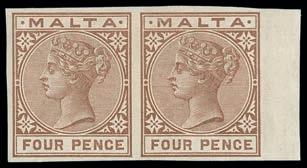CollectorsClub Philatelist
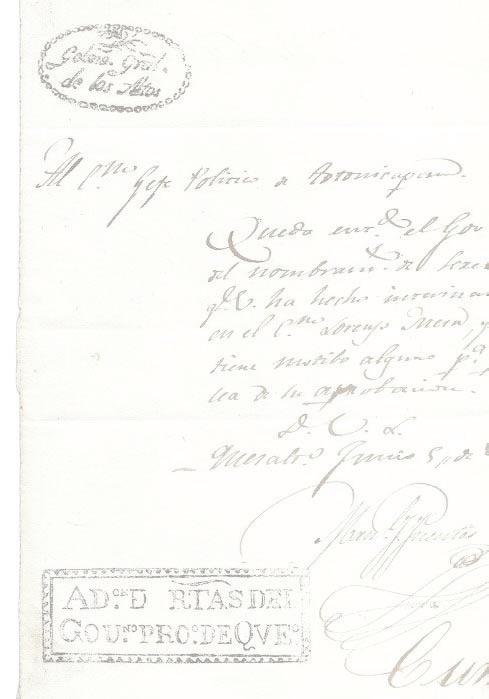
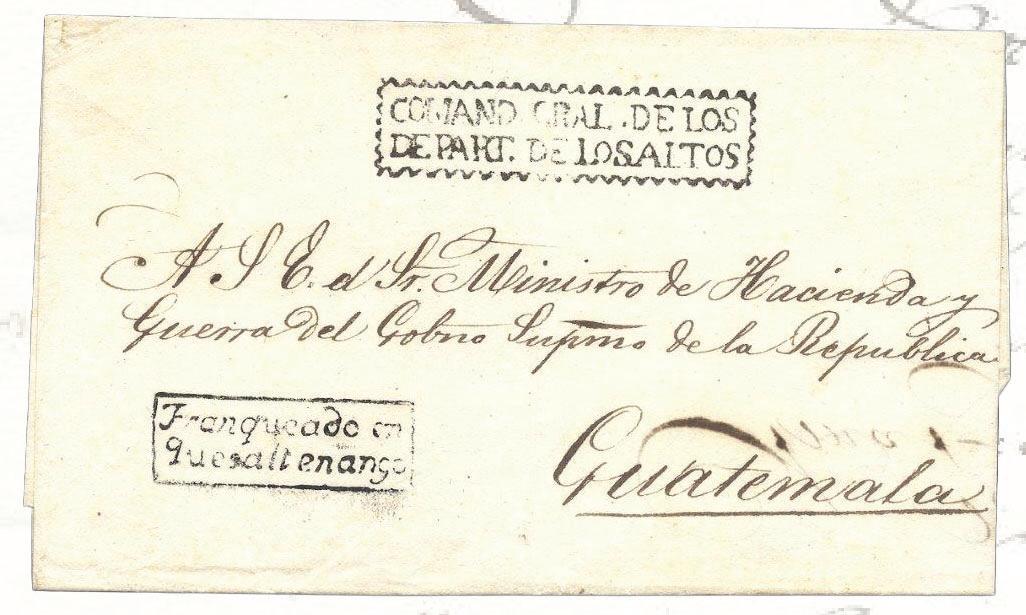



30 September 2025




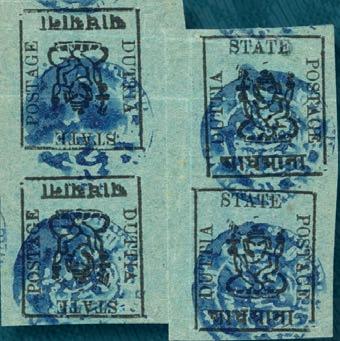


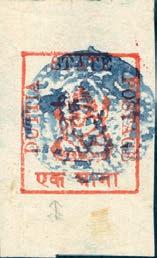






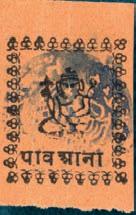









Editor: Wayne L. Youngblood wystamps@gmail.com
Layout and Design: Jason E. Youngblood jyoungblood@gmail.com
Publications Committee:
John Barwis, RDP
Robert Gray
James Grimwood-Taylor, RDP
Matthew Healey
Daniel M. Knowles, MD
Robert P. Odenweller, RDP (member emeritus)
Advertising Manager: Robert Gray robertgray@me.com
Book Review Editor: Dr. Luca Lavagnino, Europe
Editorial Correspondence: wystamps@gmail.com
Business Correspondence: 58 W 40th St, Second Floor, New York NY 10018
Tel. (212) 683-0559 email: info@collectorsclub.org
Website: www.collectorsclub.org
Executive Secretary and Librarian: Andrea Matura collectorsclub@collectorsclub.org
Authors’ guidelines for the CCP are available from the editor.
New Monograph on the Postal History of the Ahmednagar Prisoners of War Camps in India during World War I.
Essential Elements - The Power of Curiosity
Richard A. Coffey
The United States Postal Service Issues two Stamps to Celebrate Boston 2026 World Expo
Yamil H. Kouri Jr
St. Louis Cashing in at the Mint
Kurt Streepy.
Guatemala and the State of Los Altos: 1838-1848
Dr. James Mazepa RDP.
Passport Envelopes of 1992 and 1994
Michael L. Wilson
Millbury Postmaster Provisional on a Folded Letter - First Example of a Precanceled Postage Stamp in America?
Jay Weiss
Production of American Grilled Stamps, 1867-68
A.J. Valente.
Heinrich Köhler & AIJP Summit: A Top Conferenceon Philatelic Treasures Nov. 13-15, 2025, in Wiesbaden, Germany.
.314
Alberto Bolaffi (1936-2025).
Departments
President’s Message.
2025 Collectors Club Programs.
Editor’s Notepad
Letters to the Editor
Book
260
The Collectors Club Philatelist (ISSN 0010-0838) is published bimonthly in January, March, May, July, September and November by The Collectors Club, 58 W 40th St. Mezzanine, NEW YORK NY 10018. A subscription to The Collectors Club Philatelist is included with dues paid by members of The Collectors Club. Subscription price for nonmembers in the United States is $70. Prices for foreign addresses and/or other classes of mail are higher depending on actual cost; consult publisher. Subscriptions for outside the United States should be paid in U.S. funds drawn on a U.S. bank. Back issues $9, including postage. For a complete list, write the publisher. Claims for undelivered issues will be honored only within six months of the date of publication. Beyond that, replacements will be provided at the single copy price. Periodicals class postage paid at New York, New York 10001 and additional offices. Office of Publication: The Collectors Club, 58 W 40th St. Second Floor, NEW YORK NY 10018 Copyright 2025 by The Collectors Club. All rights reserved. We do not give implied or other consent for copying for more than personal use. Indexed in PhiLindx by E.E. Fricks and included in the article index of the American Philatelic Research Library and the Global Philatelic Library. The opinions and statements contained in the articles are those of the authors and not necessarily those of The Collectors Club, its officers or staff
POSTMASTER: Send change of address to: The Collectors Club Philatelist, 58 W 40th St. Second Floor, NEW YORK NY 10018
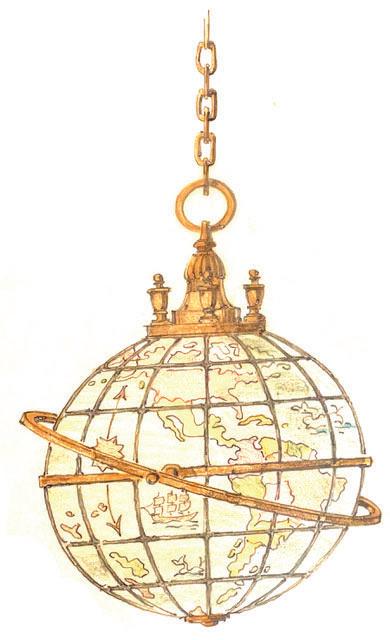
58 W 40th ST, MEZZANINE, NEW YORK NY 10018 (212) 683-0559
The Collectors Club is open Monday through Friday, 10 a.m. to 5 p.m. Please call ahead if intending to visit.
Officers
President Lawrence Haber
Vice President Robert Gray
Secretary Matthew Healey
Treasurer Roger S. Brody, RDP
Chief Technology Officer Joan Harmer
Governors
Class of 2025
Robert Gray
Lawrence Haber
Matthew Healey
Daniel J. Ryterband
Wade E. Saadi, RDP
Class of 2026
Roger S. Brody, RDP
Vincent Cosenza
Joan Harmer
Kathryn Johnson Behruz Nassre
Class of 2027
Mark E. Banchik
Alan R. Barasch
Stephen Reinhard
Robert G. Rose
The Collectors Club Philatelist is an international specialty journal serving the needs of hundreds of collectors worldwide. It serves as the journal of record for the Collectors Club as well as publishing stimulating and helpful articles for collectors of many levels and specialties. The Collectors Club Philatelist strives to publish accurate philatelic information and serves as a forum for communication among members of the Collectors Club.
258 www.collectorsclub.org September-October 2025
Lawrence Haber
Over the past six years, I’ve attended more shows and meetings than I can count. As I wander through an event, chatting with friends and acquaintances, one topic almost always comes up: the state of philately – more specifically, organized philately. I don’t claim to have special expertise, nor am I aware of any rigorous, long-term studies that shed light on the issue. Still, like many others, I form opinions based on anecdotal observation. My thoughts are no more inherently valid than yours.
Before discussing why organized philately matters and why it needs to be preserved and strengthened, we should ask: why does it seem that our numbers shrink year after year?


Our hobby isn’t immune to broader cultural and societal trends. If you’ve spoken with me recently, you’ve probably heard me mention Bowling Alone by Robert Putnam, first published in 2000. In his book, Putnam documents the decline in membership across many types of volunteer organizations in the United States – from religious congregations and fraternal orders to PTAs, veterans’ groups, bridge clubs and, yes, stamp clubs. His title refers to the sharp drop in bowling league participation, which has led to more people bowling alone – or not at all.
Putnam attributes this decline to a loss of social cohesion – what he calls social capital. The causes include:
• Generational change. The older, civically engaged “long civic generation” has been replaced by younger, less-involved cohorts, accounting for roughly half of the decline.
• Technological change in leisure. The rise of television and, later, the internet and screens has shifted time toward solitary entertainment and away from face-to-face interaction.
• Suburbanization and commuting. Urban sprawl and car dependence mean longer commutes and less neighborhood contact, weakening local networks.
• Work and family changes. More two-income households, greater time pressure and unstable employment leave less time for clubs and volunteering.
• Political and cultural shifts. Increased polarization and declining trust in institutions has eroded civic engagement and voter participation.
We’ve experienced some of this within our own club and with virtually every other philatelic organization. Moving programs online via Zoom has expanded our reach dramatically – an undeniable success. But there’s a trade-off: real-time, inperson contact is irreplaceable. What’s lost? Serendipitous discovery – the chance encounters, unexpected finds and unscripted conversations that enrich our experience.
If we accept that much of the hobby’s current state reflects larger social and cultural forces, then solutions may lie outside philately. Other fields facing similar challenges have found creative ways to adapt, and we can learn from them.
Once upon a time, a Wall Street philatelist might finish work at 4 p.m., stop by the club, sink into a chair with a cigar and a whiskey and chat about new issues or discoveries. That world is gone. Today, work ends later, commutes are longer, family responsibilities take precedence and leisure time is scarce. We can’t simply bring back the past.
What we can do is find new ways to foster interaction, through events, yes, but also by looking well beyond the boundaries of our hobby for ideas worth borrowing. The path forward may be one others have already walked; we should not be afraid to follow it.
Now, usually these dialogues in the CCP are really not dialogues: given the limitation of print, they are essentially one-way communiques. But we have new tools, and I encourage you to try them out. Over at our substack, https://collectorsclub.substack.com/, we’ve opened up the chat feature. Go over there and have a look and have a say. We’ve opened a thread on this topic with this piece as the first post. What do you say?
* All Programs will be available via Zoom; programs that will only be available online are noted as: (Zoom only)
Oct. 9 Korean War POW Mail, John Hotchner
Oct. 22 The Lithographed Washington-Franklin Heads, Andrew Kelley
Nov. 5 Single-Frame Competition
Nov. 12 We were British Once, Tim O’Connor
Nov. 19 The U.S. 10¢ 1869 Issue – A 50-Year Study of Postal Uses (tentative), Michael Laurence
Dec. 3 Hong Kong, China overprints, Ian Gibson-Smith
Dec. 10 Governors Open House,
Dec. 17 Trinidad Britannia issues, Nigel Mohammed (Zoom only)
260 www.collectorsclub.org September-October 2025
Wayne L. Youngblood
I know we look like twins, but there are subtle differences between us.
During the recent GASS (Great American Stamp Show, Aug. 14-17), I had the rare privilege of having my eldest son, Jason, attend part of the show (he’s on the left). As near as we could figure, it’s been at least 35 years since we’ve attended a stamp show together.

Since the dark days of Covid in 2020, Jason has been slowly working his way into the philatelic publishing world, starting first as designer for the German Philatelist and, more recently, taking over most design and layout functions for the CCP and the Civil War Philatelist. He also recently started as an associate editor for First Days, publication of the American First Day Cover Society.
Aside from the fact it was simply great to see the kid, he was able to meet with most of his philatelic clients – and he had fun. You see, Jason has once again been bitten by the bug and has resumed some of his collecting activities (in his “spare” time around life as a videographer and parent).

As a side note, GASS was, in my opinion, one of the best-attended national-level shows in recent years. On opening day, there was a line of at least a couple of hundred collectors anxious to get on to the floor, as you can see in the photo at left, taken as the doors opened. Let’s hope this trend continues!
All Collectors Club presentations are currently held online, via ZOOM, beginning at 5:30 p.m. (Eastern). Although there is no cost, pre-registration is necessary.
As an addition to William Kelly’s piece on the “Development of the “Congo Free State Postal System 1885-1908,” in the July-August issue of the CCP (page 212), I offer the following.
The Belgian Congo postal administration received complaints in 1897 about double postal cards (with paid reply) whose reply section had been stolen enroute. The administration knew that some double cards were being separated by the user and sent as two single cards, which was legal. The post office ordered its employees to indicate – first by manuscript and then with a handstamp – on any detached double cards (message or reply half) that had arrived at the office separated, to limit the postal service’s liability and prevent unjustified claims.
To compound the difficulty, some offices lacking single cards cut up double cards and debited them as single cards. They were ordered to apply the handstamp “incomplete postal card” to each half of these cards before putting them on sale.
In the first case, the “incomplete postal card” stamp is a postal mark indicating that the reply is absent; in the second case, it is an overprint transforming half of a double postcard into a single postcard, thus creating a new postal stationery item. It is not possible to make this theoretical distinction for the items sent.

The first handstamps were issued in early 1898 to the three offices located at the mouth of the Congo River: Banana, Boma and Matadi. They bore the name of the office and “incomplete card” in a frame.

All correspondence from the interior of the country was concentrated at Boma, the main exchange o ffi ce for abroad; incomplete cards, postmarked by the o ffi ce of departure (about 20 in 1900) received the Boma overprint upon arrival at this o ffi ce. The Banana and Matadi postmarks were only applied to cards originating from the o ffi ce itself. This is why

the Boma overprint was, at fi rst, by far the most common.
From 1900 onward, the interior offices received a postmark, without an office name, labeled “Incomplete Postcard,” without a frame.
Most of these stamps measure 51 millimeters, a few are only 49mm and Léopoldville used a 61mm stamp from 1909.
The overprints on the cards of the Independent State are found indifferently in blue or black; on the Belgian Congo postcards they are black. The overprint is applied to the front, either on the legend or on the upper-left part of the space reserved for the address. About 31 issues of double cards were separated and overprinted.
— Wayne Menuz via email
Did you know...
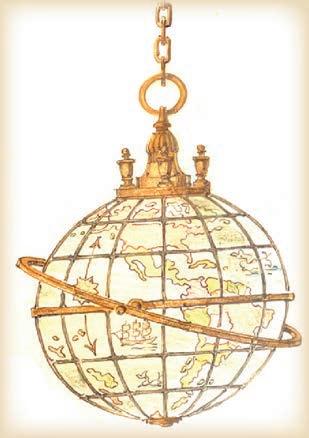
...there are many CC meeting presentations available to members on our website?
www.collectorsclub.org You don’t have to live in Manhattan to be an active, involved and happy member of the Collectors Club.
This is just one of the many, many member resources available to you!
The Military Postal History Society just published its fifth monograph on war-related subjects designed to captivate historians, philatelists and war enthusiasts. Authored by Robert Gray, this meticulously researched 136-page, 8½- by 11-inch, all-color monograph sheds light on an intriguing – yet often overlooked – chapter of wartime history. With its focus on the postal history and daily life within the Ahmednagar Prisoners of War Camps, the book offers a rare glimpse into the human stories and administrative complexities of internment during World War I. Readers will find an invaluable resource that combines historical depth with detailed postal insights, making it a musthave for collectors and scholars.

There were unique aspects of the Ahmednagar Prisoners of War Camps, which housed approximately 1,700 prisoners at capacity and interned 2,500 men overall. Most prisoners were German and Austrian nationals residing in India at the outbreak of the war on Aug. 4, 1914, including missionaries, sailors, soldiers and professionals. Joining them were more than 500 German East African soldiers and 150 Germans and Austrians from Thailand.

The work highlights the exceptional amenities provided at Ahmednagar, such as access to alcohol, photography, a theatre, library and sports facilities, making it distinct from other World War I POW camps. It also explores the transfer of prisoners to civil camps and their repatriation during the war. It is well documented with footnoting, bibliography and index.
The work provides extensive details on the postal history of the Ahmednagar camps, including:
• Inbound and outbound mail routes, rates, and markings.
• Examples of registered mail.
•A guide to camp postal stationery and Ahmednagar cancelers.
• Postal history of civil camps at Ahmednagar and Yercaud.
Illustrations, all in color, feature handstamps not previously documented, layouts of the camp, forwarded mail, intercamp mail, registered mail and mail to special destinations.
The monograph contains two appendices. Appendix 1 provides a guide to the camp’s postal stationery. Appendix 2 offers a URL where readers will find more than 2,700 entries listing prisoners’ names, places of origin, professions and prisoner numbers. This appendix offers a valuable resource for researchers and historians alike.
The monograph is available for purchase at Amazon as a print-on-demand book. The cost is $19.95 plus shipping and sales tax. For details and how to order a copy, visit
https://www.amazon.com/dp/B0FJM8FTTS
Contact: monographs@militgaryphs.org
The Ahmednagar Prisoners of War Camps India, 1914-1920: A Postal History
By Robert Gray
Military Postal History Society, 2025
ISBN #979-8-2904944-9-4

Richard Coffey
As with most endeavors powered by curiosity, philately is forever open to re-examination, to re-appraisal, to scholarly criticism of postal history and its artifacts. We are as grateful for newly discovered material as we are for new interpretations of the old – and particularly enthused to study fresh insights exposed by the common artifacts in our own collections.
Mit Luftpoat iacA No rda •e rika
Hernt Carl Con 2331 Dwi1,llt Way
Snj. E:rollleia


Berli•-Ckarlotteabur, 4 Dro se•atr 9

As philatelists we have seen our world sputter in despair at cruelty in evidence on postal matter. A Nazi executive order of Aug. 17, 1938, required German Jews bearing first names of non-Jewish origin to adopt an additional name: “Israel” for men and “Sara” for women. Often called the “Sara letters,” this regulation was a Nazi scheme to force Jews to reveal their heritage on all paperwork, including the mail so as to be easily identified. This cover was mailed in March 1941, from Halensee (tenement district in Berlin) paid with a 40pf Hindenburg Medallion (Scott 420) and a 25pfennig Monument to Prince Eugene (Scott 505); 65pf paid the airmail rate to North America and to its destination in Berkeley, Calif.
In my small world this chain of discovery and rediscovery, has continued to excite me through a lifetime of acquisition, accumulation, accession and even now, during my final repose.
I have been most fortunate to have lived in a time when the freedom to explore the world around me has been considered a useful contribution; to be one of millions of students who have discovered and highlighted the significance of a public post which, 400 years ago, enabled – for the first time in human history – an individual’s right, rich or poor, to share his thoughts and fears and dreams, with an audience of his choosing, in the safety and succor of the public post.
The mysteries we study as philatelists, many of which lie beyond our ken, perhaps beyond our senses, have prevailed, in rich times as well as in dark passages when certainties disappear, when lifetime values lose their luster and memories are painted over with alternate realities.
We see these political transitions in our stamps, these human artifacts of paper and ink, created in periods of peace and war, during the intellectual times and in the vacuous times of despair. We have seen our world in times of humility and generosity and in times when selfishness and greed flourish.
Our past is recorded on postage stamps and covers, proof that we have been in this place before and warning that our prosperity cannot protect us from ourselves.
In the lean times, however, those who read history, those who have the curiosity to fathom the truth, also have the power and the responsibility to stand by the facts and to debate the facts as they understand them – this we’ve learned as well, from the past in the pages of our albums and on the face of our covers.


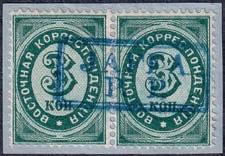


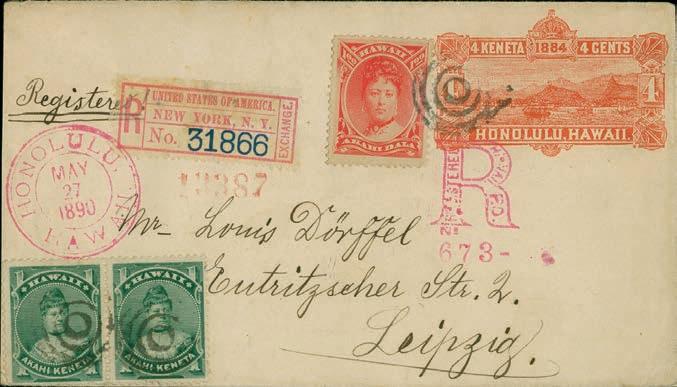


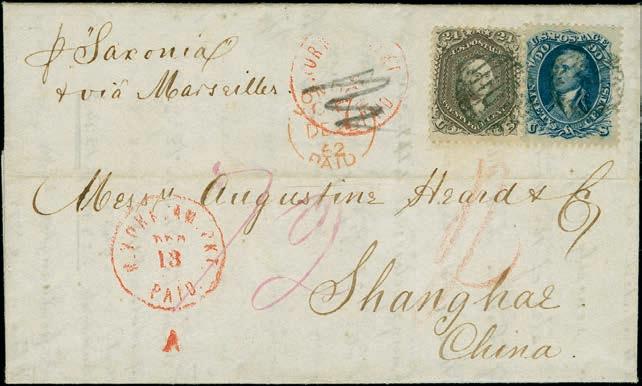
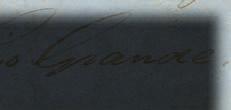


As the oldest stamp auction house in Switzerland, situated in the international financial centre of Zürich, we at Corinphila Auctions know the market.
The most specialised philatelic knowledge, fastidious presentation and an international customer base with strong purchasing power, guaranteed and verified hammer prices.
Single-Owner Sales, and printed Catalogues, are our speciality!
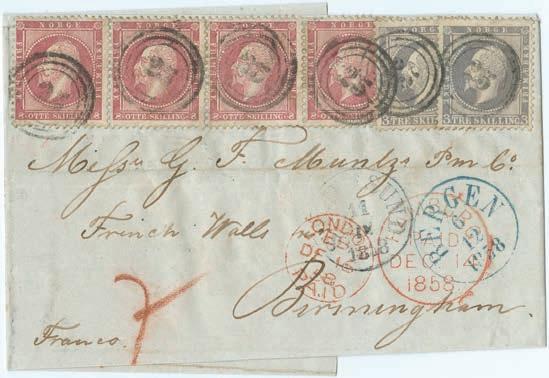

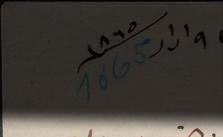



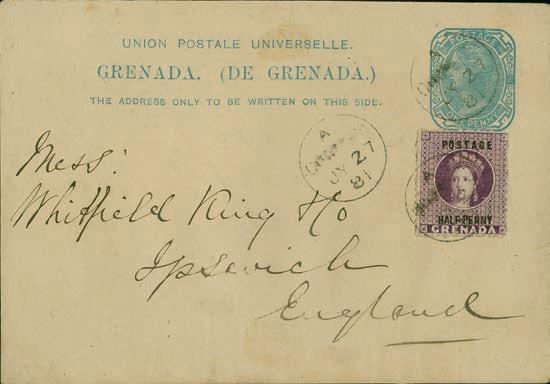



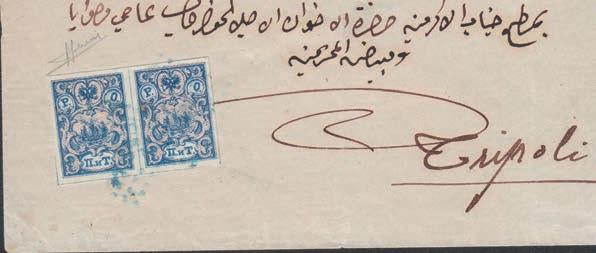

We are open to discuss important holdings in a meeting with you, possibly in your home.
Special auction “Switzerland” 10 October 2025.
Selling or buying – the next Corinphila Auction Event Week is 24 – 29 November 2025.
Latest date for consignments is 5 September 2025.








On Aug. 14, 2025, the United States Postal Service (USPS) issued two nondenominated Forever stamps to celebrate Boston 2026 World Expo (Boston 2026). This continues a century-long tradition by the USPS to issue stamps or souvenir sheets to advertise upcoming world philatelic exhibitions in the United States.
Since 1913, the United States has hosted world philatelic exhibitions once every decade. The first five exhibitions were held in New York City. The initial commemorative stamps were issued for the second world philatelic exhibition in 1926. A souvenir sheet of 25 stamps depicting the Battle of White Plains had the text “INTERNATIONAL PHILATELIC EXHIBITION OCT 16th TO 23rd 1926 / NEW YORK NY USA” printed on the selvage.
In 1936, an imperforate souvenir sheet of four different commemorative postage stamps that had been previously released in 1935 and 1936 was issued “IN COMPLIMENT TO THE THIRD INTERNATIONAL PHILATELIC EXHIBITION OF 1936.” Also, four poster stamps with the same design in different colors and no value were issued to advertise this “International Philatelic Exhibition.” With an elaborate design, they were printed by the American Bank Note Co.
The fourth exhibition was held in 1947, for which an imperforate souvenir sheet reproducing the first two U.S. stamps of 1847 was created. The stamps have the original values of 5¢ and 10¢.
Another imperforate souvenir sheet was issued in 1956 for “FIPEX” (Fifth International Philatelic Exhibition). Its two stamps, with 3¢ and 8¢ denominations, illustrate the top half of the Statue of Liberty.
In 1966, the Sixth International Philatelic Exhibition exhibition was held in Washington, D.C., and was named “SIPEX.” An imperforate souvenir sheet was produced showing the U.S. Capitol, the Washington Monument, and a 5¢ stamp illustrating a stylized envelope.
The 1976 exhibition, “INTERPHIL ‘76,” was held in Philadelphia, Pa. A 13¢ stamp was issued showing two perforated red, white and blue strips forming the number “76.”
Chicago held the next world philatelic exhibition. The highly successful “AMERIPEX ’86” was, at that time, the largest stamp show ever held in the United States. A 22¢ stamp showing part of a stamp issued in 1886 with Benjamin Franklin’s profile was released to celebrate this exhibition.
The next exhibition, in 1997, took place in San Francisco. Two different perforated triangular stamps were printed in a souvenir sheet of 16. The 32¢ stamps had two designs, a stagecoach in red, and a clipper ship in blue. The top of the selvage included the text “PACIFIC ’97 INTERNATIONAL STAMP EXHIBITION, SAN FRANCISCO, CALIFORNIA, MAY 29-JUNE 8, 1997.”
In 2006, the exhibition was held in Washington, D.C., for which a souvenir sheet was issued depicting the U.S. Capitol and reproducing the $1, $2 and $5 stamps of 1923 in their original colors with perforations. These stamps show the Lincoln Memorial, the U.S. Capitol and the head of the “Statue of Freedom,” respectively.
The most recent decennial exhibition went back to New York in 2016. A pair of light blue and light red non-denominated forever stamps were issued to commemorate this show. The have the same geometrical designs with a star in the center inside a clear circle with the text “2016 WORLD STAMP SHOW / NEW YORK CITY.”
The Boston 2026 stamps, showing the historic Old North Church and a latenight rider sounding the alarm, are reproduced nearby.
Boston 2026, the 12th decennial world philatelic exhibition in the United States, will be held at the Boston Convention and Exhibition Center May 23-30, 2026. For the latest news and information please visit our website www.boston2026.org. Yamil H. Kouri, Jr. - President Yamil.Kouri@Boston2026.org

Germany’s Oldest Stamp Auction House


18 – 27 September 2025
Universal Postal Union (“UPU”) and Its Impact on Global Postal Services –The JP Gough Collection
Russia No. 1 – extracts from the "Elin" Collection
India – Lithographed Issues incl. great rarities
Ship Mail to 1945 – The Friedrich Steinmeyer Collection

Great Britain – Queen Victoria – The Line Engraved Imperforate Adhesives – The Richard Frajola Collection
Germany from 1849 – The "American" Bruce Wright Collection (part II)
Heligoland – The Hans-Jürgen Borowski Collection (part III)
Original printing clichés Heligoland and Romagna
Russian Mail – The Jack Moyes Collection The Kiefersfelden Stamp Find –Great Britain Kingdom of Hanover – The Knut Gerschau Collection German Empire – Shield Issues 1872–75 – The “Baghira” Collection (part II) German Colonies and German Foreign Post Offi ces – The “Calibra” Collection (part II) Danzig – From pre-philately to 1945 – The Ton Hulkenberg Collection (part II) The City of Munich from 1519 – Homeland Collection
Contemporary German History 1941/48 – The Dr. Heinz Jaeger Collection Original Designs Germany by artist Heinz Schillinger
Exceptional rarities for collectors.
Order our premium catalogues today or visit www.heinrich-koehler.de
Address
Hasengartenstr. 25 65189 Wiesbaden, Germany
Phone What sApp
Contact
+49 611 34 14 9 0
+49 172 666 72 45
www.heinrich-koehler.de info@heinrich-koehler.de




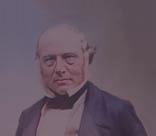
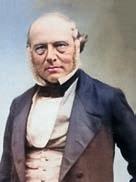


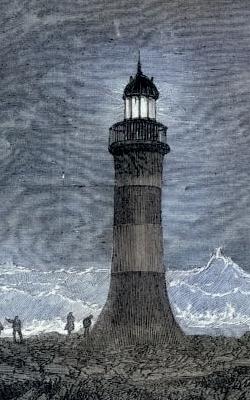
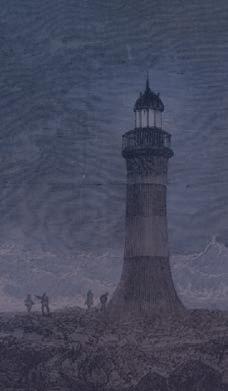






Great Britain 1840, 2 d. blue, horizontal strip of four on letter sheet to the Cape of Good Hope.
Provenance: Dr. Chan Chin Cheung (1961) 'WILLS' Collection (1989)
Great Britain 1840, offi cial stamp "VR", imprimatur sheet corner with plate letter "A". Unique.
Provenance: Leonard H. Clark (1946) 'CHARTWELL' Collection (2011) Simon Beresford-Wylie (2024)
British “anti-war cover” with Prussia 1850, 3 silver groschen from Hamburg to Leipzig.
Russia 1858, 10 kopeck, a marvellous corner copy, tied by purple-red double line of Lenzenhof (Latvia) to letter sheet. An outstanding No. 1 entire.
Provenance: Liphschutz, Bianchi, Elin
Kurt Streepy
Wayne Youngblood’s article on St. Louis cancels in the March/April issue of Collectors Club Philatelist (Part I, page 112) reminded me of an interesting cover. I originally picked this cover up for my first-issues-of-the-world collection (https://youtu.be/DTiOlemx6Pw), but moved it to my inventory when I picked up a different example. Collecting first issues of the world started out as a fun way to collect the world while focusing most of my attention on my specialty of U.S. Possessions and Central America. Like any collecting area, it is not hard for things to escalate quickly.
The Scott No. 1 looked lonely on the album page, so I expanded to the first issue (first set). As the sets filled pages, a bug developed for finding the first issues of each country on a cover. The hunt began as I attended shows and perused auctions. Suddenly, my side fun collection became my main passion outside of the exhibits I was developing.
This led to the purchase of a U.S. No. 2 folded letter from St. Louis to Philadelphia, Aug. 8, 1850. St. Louis is not a rare postal marking and Philadelphia is one of the more common destinations. What made this piece interesting was the content of the folded letter.
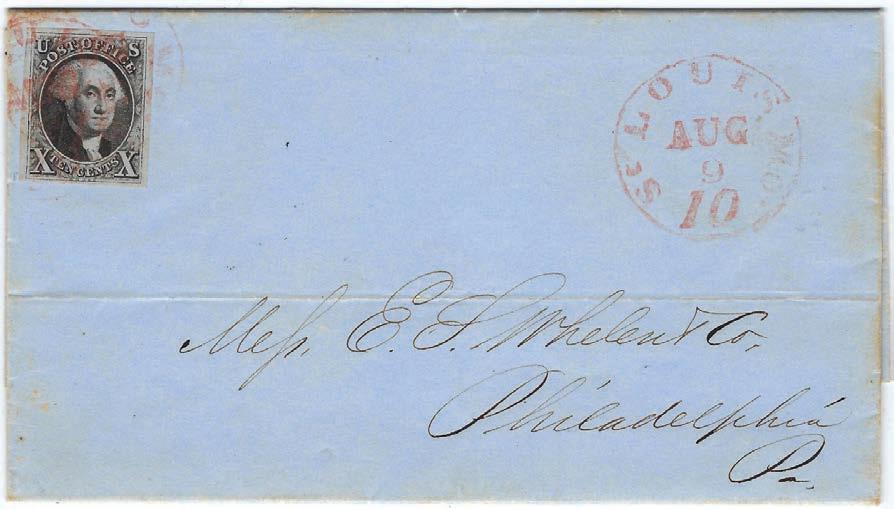
I :1(/' 1!f;Lr _/c.,-~, i"Y£,,, //_/;/{-(';, / ;;' r ~r'.f',,(. ,,./ ,~ ' ',,,_..c /.,,. ;(£;#"'~ _;,,:, ) -,,;3,-~., - r _,fll'I',, / /

and transcribed content (below).
St. Louis Aug 8, 1850
E.L. Whelen Co.
Philadelphia
Gentleman
We send you today by Livingston Freight to Philade. ……..
One package containing 26 oz gold dust
1 Mormon coin
1 counterfeit doubloon
Please send these to the Mint for coinage Place proceeds to our credit and advise us
Please sent….
Yours Rufus LA Benoist and Co.
LA Benoist and Co. was founded by Louis Auguste Benoist (1803-67), an American banker from St. Louis. His operation was one of the leading banks in the Southeast in the mid-1850s. I was unable to find a reference for Whelen Co. of Philadelphia that was assisting with the transaction.
Club Philatelist
Volume 104, Number 5
Gold in 1850 was $20.67 per ounce or approximately $850 per ounce in 2025 dollars – a bargain compared to more than $3,000 per ounce value currently. I’m not sure the content of a counterfeit doubloon but guess it was gold or silver. Morman gold coins were struck by the Mormon church from 1848-60 in Salt Lake City. They were issued in $2.50, $5, $10 and $20 denominations before the church was ordered to stop production in 1861 by Alfred Cumming the governor of Utah Territory. The coins are now worth from tens of thousands of dollars to more than a million dollars each. Unfortunately, it sounds like this one was melted down for coinage.
Folded letters offer some interesting snippets of history that are often more interesting than the covers themselves. Unfortunately, it may not be long until that script writing will be a foreign language to most.





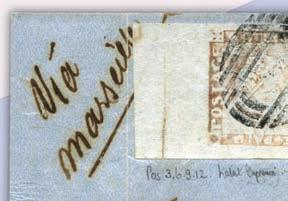














Dr. James Mazepa, RDP
Colonial Guatemala declared independence from Spain on Sept. 15, 1821, and the Central American Federation was formed on July 1, 1823. The Federation comprised the five states of Guatemala, Honduras, Nicaragua, El Salvador and Costa Rica. The creation of the Federation provided a situation not only for new hopes and discussions between the States, but also for old rivalries to surface. Several territorial adjustments were implemented. Sonsonate was incorporated into El Salvador in November 1823, and Nicoya was annexed to Costa Rica in July 1824. Even during this early stage of the reorganization of boundaries within the Federation, there was some discussion of the highland districts of Guatemala, namely, Quezaltenango, Totonicapán and Sololá, which included the cities of Retalhuleu, Cuyotenango, Huehuetenango and Mazatanango. These would constitute the sixth state of the Federation. At this time, these districts had more than 200,000 inhabitants, 129 villages and sufficient resources to maintain itself.
The governing powers in Guatemala realized that creating such a state would weaken Guatemala vis-à-vis the other States of the Federation, so little was done to accomplish the formation of a new state on Guatemalan territory. However, rebellions arose among the indigenous peoples in the highlands who protested the reversal of concessions long granted them, especially that of not having to pay taxes.
Tensions grew within Guatemala between liberal and conservative factions, which prompted Rafael Carrera to begin a war that eventually dissolved the State. The conservative Carrera captured the capital on Jan. 31, 1838, and Pedro Valenzuela took charge of the government on Feb. 2, 1838.
Also, on Feb. 2, the Liberals in Quetzaltenango declared succession from Guatemala and proclaimed Los Altos the sixth State of the Central American Federation, with Quetzaltenango as the capital. The districts of Totonicapán and Sololá joined Quetzaltenango on Feb. 5. A Constitutional Assembly was convened in Quetzaltenango on Dec. 25, 1838, and Marcelo Molina was elected chief of the State of Los Altos (Figure 1 and Figure 2).
On April 17, 1839, Guatemala declared itself independent of the Central American Federation, and the other States of the Federation soon followed. Thus, the Central American Federation was dissolved, and the five states of the Federation became independent. What followed was a prolonged period of political, civil and military strife.
278 www.collectorsclub.org September-October 2025


Los Altos was a haven for liberal Democrats. The Carrera government objected to many of the statutes of the Los Altos Constitution, especially that of the freedom of the press, which continued to criticize the Carrera regime. These criticisms eventually became their undoing. The State of Los Altos was occupied by Carrera’s army on Jan. 29, 1840, and reincorporated into Guatemala.
Not to be outdone by the central government in Guatemala, the district of Quetzaltenango declared the renewed existence of the State of Los Altos on Aug. 26, 1848, and called on the other districts to join it. Again, the Guatemalan army occupied these districts, and the State of Los Altos was reincorporated into Guatemala for the final time on May 15, 1849.
In the years I collected Guatemala pre-stamps, I always looked for letters related to the state of Los Altos; one would assume the post continued as usual. Finally, I was able to find postal documentation of Los Altos.

3.
Figure 3 shows a non-dated outer letter sheet with an official serrated rectangular box cachet “COMAND.GRAL.DE LOS/DEPART.DELOSALTOS” (Commanding General of the Department of Los Altos). It is addressed to the Magistrate of Totonicapán.
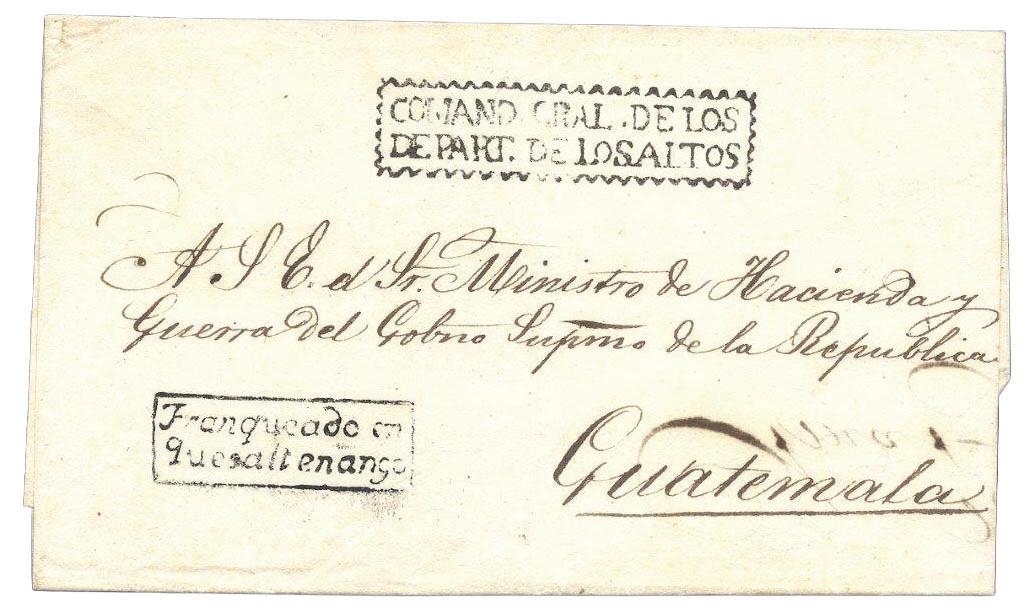
Figure 4.
1:1 ~c-11q·c~•.:: u~c , -:-, i l'l u c ,a l tP.na.ns ~;
Figure 4 pictures an outer letter sheet with the same official cachet as Figure 3. This letter is addressed to “El Sr. Ministro de Hacienda y Guerra del Gobno. Supmo. De la Republica/Guatemala” (To the Minister of Revenue and War of the
280 www.collectorsclub.org September-October 2025
Supreme Government of Guatemala). The letter is also postmarked “Franqueado en/ Quezaltenango” (Harris #166). This postmark is recorded as used between 1833 and 1861.

Figure 5.
Finally, I discovered what I believe to be the correspondence side of a folded letter (Figure 5). It is dated “June 6, 1838, at Quetzaltenango” and was signed by “Jose Gabriel Saenz.” Then follows the note “Revenue Accounting of the United Departments of Los Altos: in Quetzaltenango on June 6, 1838. It has been registered. s/s ARA”
On the obverse, at the top, is a black seal of “The General Government of Los Altos”(Figure 6).
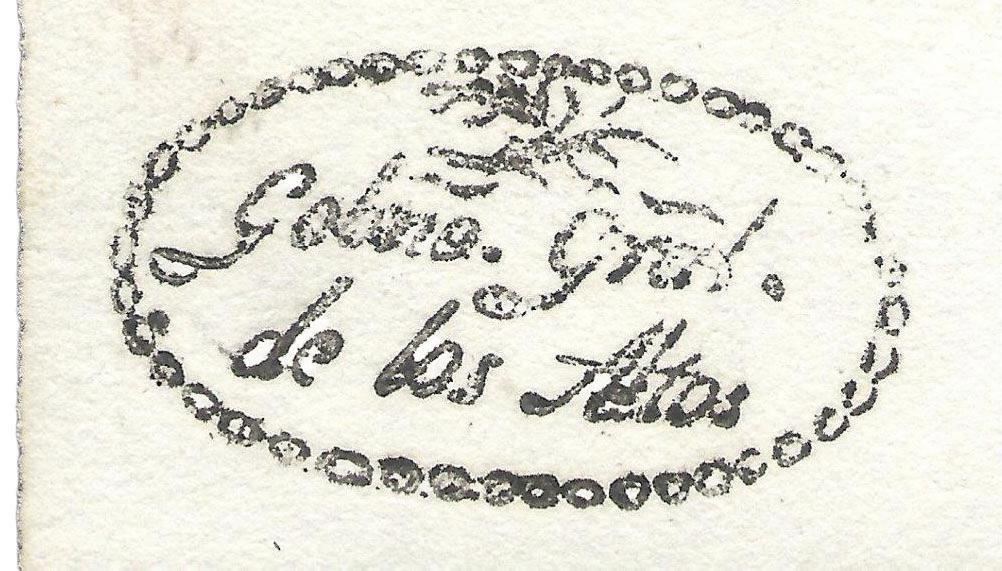

Figure 7 shows the message:
“To the Citizen Political Chief of Totonicapam.
The government has been notified of the interim appointment of the Secretary in the person of Citizen Lorenzo Mesa and there is no reason whatsoever for it not to be approved.
s/s D.C.L.
Quetzaltenango June 5, 1838
s/s Manuel J. Fuentes”
The bold rectangle at the bottom reads:
“ Administration of Revenue of the Provisional Government of Quetzaltenango”
These letters and documents confirm that the post offices continued functioning during the short-lived State of Los Altos. Hopefully, other letters that were circulated during the State of Los Altos can be found.
References:
Perez-Brignoli, Hector, A Brief History of Central America, University of California Press, 1989. Bancroft, Hubert Howe, History of Central America, Vol.III, A.L. Bancroft and Co., San Francisco, Calif., 1883.
Goodman, Ed., Roland A., Guatemala-1, Robson Lowe, Ltd., 1969.
Harris, Leo J., Postal History and a Listing of Prephilatelic Postmarks Central America, Collectors Club, Inc., New York, 1986.
Write a Letter to the Editor!
Dan Undersander

United States Department of State
Chicago Passport Ai,ency Kluczynski Fede<al Bu,ldlng, Sutte 380 230 South Dearborn Street Chicago, IL 60604·1564
Offteial Business Penalty lor Private Use, $300
In 1989 the United States Postal Service encouraged Federal departments to use officially stamped envelopes, rather than penalty mail, to provide better accounting for actual postage used.
On March 17, 1990, two envelopes were released, primarily for use by the Consular Service. The face values were 45¢ (the double first-class letter rate, United Postal Stationery Society OM23 and OM23A) and 65¢ (the triple rate, OM24) for one and two passports, respectively.
Congress established the Consular Service, distinct from the fledgling Diplomatic Service, in 1792. The consular function was then primarily concerned with providing U.S. passports to American citizens wanting to travel abroad.
Some in the Consular Service wanted a Bicentennial envelope in 1992. This was first denied but with a rate increase scheduled to take effect early in 1991, Citens Stamp Advisory Committee and the USPS staff knew they would need to replace the 45¢ and 65¢ stamped envelopes then in use for mailing passports. So, it was decided to issue the new-rate envelopes bearing a design commemorating the Consular Service’s anniversary in place of the standard Eagle stamp.
The first-class rate change from 25¢ to 29¢ (second step 52¢, third step 75¢) became effective Feb. 3, 1991 – too soon for new designs to be developed, printed and distributed. However, the new designs were available for the bicentennial year (1992) of the Consular Service.
John Hotchner (“The Development and Use of Consular Bicentennial Postal Stationery 1990-94,” Postal Stationery, May-June 2019, pp. 115-123) detailed a design contest conducted for the stamp to begin the Consular Service Bicentennial celebration. Approximately two dozen entries were received by the Aug. 15, 1991, deadline. An entry submitted by a college student working as a summer State Department employee was selected, which was a horizontal rectangle incorporating the colors of the U.S. flag and showing a blue globe in the center of a large white star, set against a red background. The design was later modified by the Postal Service to that shown in Figure 1, but kept many of the essay’s concepts.
As the envelopes were used, complaints began to be received that some envelopes were received torn and missing the passport. This appeared to be happening only to envelopes that had been run through canceling machines and was traced to the tendency of envelopes with thick enclosures to split under stress.
The State Department asked for 28-pound paper to be used in place of 24-pound paper. When the change was made to heavier paper, the design and format remained the same, resulting in UPSS types OM39 and OM40.
However, several other noticeable differences occur between the two printings:
The copyright date under the flap on the back of the envelope was changed from left to right when viewed from the envelope back.
A comma was added after the word “Use” in the phrase “Penalty for Private Use $300” that was below the return address block on the 1992 version.
The word “Business” below the return address block ends above the “a” of “Private.” It ended above the “t” on the original.
The paper of the reprint is a slightly different color, having a bluish or grayish tint, as compared to the yellowish original.
There were at that time 14 passport agencies located in Boston, Mass.; Chicago, Ill.; Honolulu, Hawaii; Houston, Texas; Los Angeles, Calif.; Miami, Fla.; New Orleans, La.; New York, N.Y.; Portsmouth, N.H.; Philadelphia, Pa.; San Francisco, Calif.; Seattle, Wash., Stamford, Conn.; and Washington, D.C. Envelopes were printed with the return addresses for each of these locations. A collection of the different agencies is difficult.
The base first-class rate changed on Jan. 1, 1995, to 32¢. Those passport agencies that had not depleted their stocks of Consular Bicentennial envelopes (for which the State Department had paid) were instructed to use them until they ran out, so a number of envelopes occur with makeup postage to the higher rate.
First example of a precanceled postage stamp in America?
Jay Weiss
The purpose of this article is to present evidence that the Millbury, Mass., Postmaster Provisional (PP) stamp on the cover written by Sarah L. Waterman and shown in Figure 1 was in all likelihood precanceled in advance of its being affixed to the folded letter that she wrote, and therefore is the first example of a precanceled stamp in America.

The cover that is the focus of this article is shown in Figure 1. It is a folded letter written by Sarah Littlefield (Greene) Waterman, with the Millbury PP stamp and postmarks of the post office applied to its exterior. Sarah L. Waterman was the wife of Henry Waterman, who ran the post office for the appointed postmaster, Asa Waters. Col. Waters was an active businessman who decided that he was too busy to actually run the Millbury post office, and essentially paid no attention to it. He appointed Henry Waterman to be in charge of its operation.¹ Waterman was a jeweler; it was he who conceived, implemented, executed and produced the Millbury PP adhesive postage stamps.² He will be referred to as the “postmaster” throughout this article.
Of interest here, and certainly evident after her marriage, Sarah was a prodigious letter writer to relatives and friends. She came from a prominent Rhode Island family (the Greenes). Figures 2a-2d show four additional covers in my possession that were written by Sarah Waterman, illustrating her propensity to write letters between mid-1840s and early 1850s, while residing in Millbury. Two are postmarked Millbury, Mass., one of these with an 1847-issue stamp affixed (letter signed by Sarah L. Waterman); the other has an 1851 3¢ stamp. A third letter, written from Salem, Mass., to Augusta, Maine (as in Figure 1), with a 3¢ 1851 stamp affixed has a gelatin flap seal on the rear reading “I’ve Been Roaming.” The fourth letter bears an 1847 stamp addressed in her handwriting and sent from Norwichtown, Ct., which is 55 miles south of Millbury, Mass. The fact that four surviving additional letters, (other than the one shown in Figure 1), were written by Sarah Waterman during this time period – all to different recipients –(therefore not retrieved from a single find), clearly shows Sarah’s proclivity for writing many letters. Others may exist, but these are the only ones that are found in my philatelic archives.







Figures 2a-2d. (pp. 287-288) Four covers/letters written by Sarah L. Waterman. Figure 1a is a folded letter with a 5¢ 1847 issue stamp affixed; different from all others shown here, it is written in pencil. Letter begins “Dear Aunt Mary, and is signed “Sarah L. Waterman” and is addressed to Warwick, R.I., where Sarah Littlefield Greene was born. The three other covers, shown on the facing page, are readily identified by her distinctive handwriting (in ink) of each address, which matches handwriting of the address on the cover shown in Figure 1. Figure 2b is a small envelope postmarked “West Millbury” and bears a 3¢ 1851 issue stamp, with notation of “1852” written in pencil. Figure 2c shows an envelope postmarked Salem, Mass., bearing a 3¢ 1851 issue stamp; on the reverse is a wafer seal reading “I’ve Been Roaming” and is addressed to Augusta, Maine, as is the cover in Figure 1. Figure 2d is an envelope with a 5¢ late-issue 1847 stamp, mailed from Norwichtown, Conn., which is 55 miles south of Millbury, Mass.
Now we turn our attention to the existing Millbury covers bearing PP stamps. These data are extemely informative. Henry Waterman was a jeweler, and apparently attention to detail and meticulousness is reflected in his handling of Millbury covers. Figures 3 and 4 (reproducing the eight existing Millbury PP covers) show that all known Millbury PP covers were postmarked in exactly the same manner – each cover has a Circular Date stamp (CDS) of the Millbury post office applied near the upper-left corner of the cover (or folded letter), then a “PAID” cancel at the center top of the cover and, finally, the rate (“5” or “V”) struck near the upper-right corner of the cover. This configuration is invariable; every cover is postmarked in exactly this way.
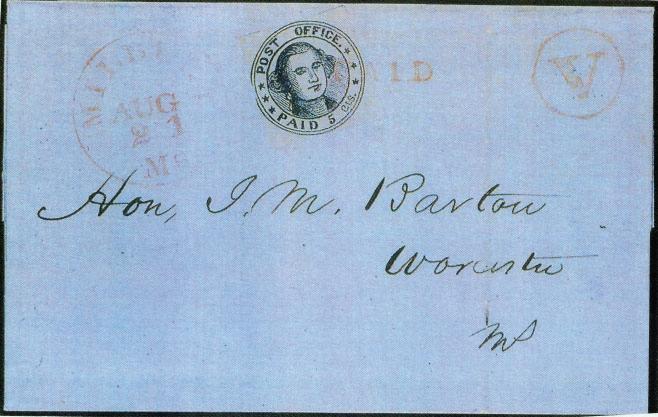


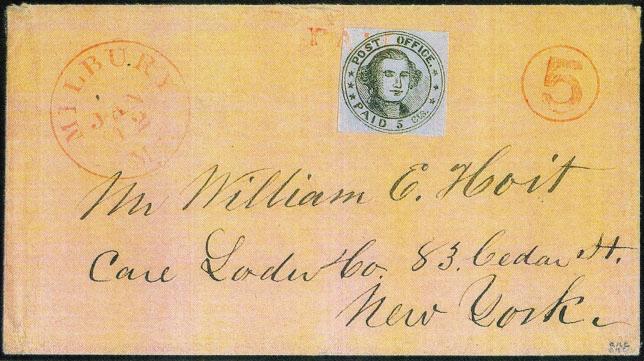
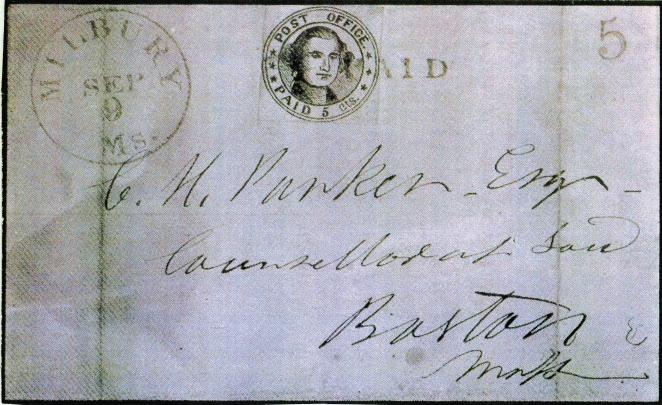
the eight-known existing full covers with Millbury
www.collectorsclub.org September-October 2025



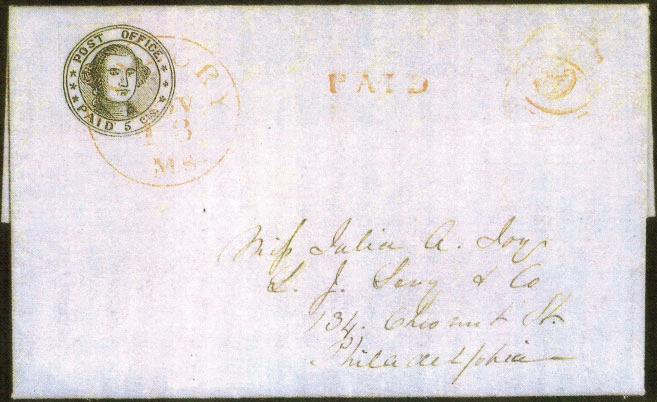
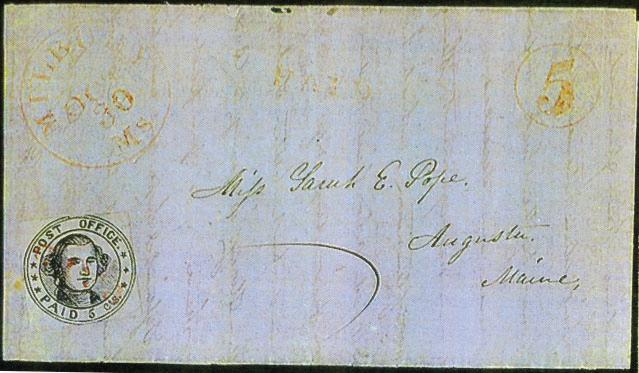
Importantly, we now examine how the Millbury PP stamps were canceled. First, in the few cases where the PP stamp was affixed near the upper-left corner of a cover/folded letter, all such stamps were canceled with the circular Millbury CDS normally applied in this location; however, stamps affixed here and canceled in this manner are not of concern for this article, as these do not relate to the Sarah Waterman stamp, which was canceled with the word “PAID.” Now, addressing “PAID” cancellations of the PP stamp, except for the last cover from Figure 4 (the Sarah Waterman cover that is also shown in Figure 1), the PP stamp, often placed at the center top of the cover, was always canceled with the “PAID” applied horizontally and partially on the stamp, with the rest of the word “PAID” progressing onto the cover front to, in philatelic lexicon, “tie” the stamp to the cover. This can be seen for six of the eight existing Millbury covers, all of which are shown in Figures 3 and 4. The consistency of this pattern is of definite importance.
292 www.collectorsclub.org September-October 2025

Figure 5. The eleven known off-cover (or on piece) Millbury Postmaster Provisional stamps. The top-left stamp is unused and uncanceled; all others are canceled.
A similar result for “PAID” cancellations as previously described is evident when one examines off-cover stamps. Figure 5 shows all known off-cover or partial cover (“on piece”) stamps; there are 11 such stamps. The stamp shown at the top left is unused – no cancel. The five stamps shown as the rest of the top
Volume 104, Number 5 Collectors Club Philatelist
row and all of the second row of the image are canceled with “PAID.” Again, as described in the previous paragraph for on-cover stamps, these off-cover stamps show clear evidence that the word “PAID” was applied horizontally with part of the word progressing onto the face of the cover; thus, the “PAID” cancellation seen on off-cover stamps was done exactly the same as evident on the full covers presented in Figures 3 and 4. Of the remaining stamps, four are canceled with the Millbury CDS (two “on piece”) indicating they were affixed near the upperleft corner on the original cover – again, with these replicating the pattern of the cover shown in Figure 3. The last stamp “on piece,” shown at the bottom right in Figure 5, is an exception that differs from all others, but its smudge cancel renders it irrelevant to “PAID”-canceled stamps.
In summary, with the exception of the stamp on the Sarah Waterman cover (Figure 1), all other Millbury PP stamps canceled with the word “PAID” (11 in total) have the cancel struck across the stamp in exactly the same configuration – “PAID” struck horizontally such that the word “PAID” always appears partially on the stamp and remainder of the word would have appeared on the face of the cover. Interestingly, we note here that most of the full covers show the stamp affixed near the center top of the cover – an unusual location – which suggests that one person (likely the postmaster himself) may have produced the stamp at the time of mailing and affixed it in this position, where he then canceled it with “PAID” (see later description of how each adhesive stamp was individually produced). Note that the “PAID” cancel on all of these stamps is never struck with the word entirely on the stamp, nor does this cancel ever differ from being placed horizonally, roughly even with the bottom of the stamp,

294 www.collectorsclub.org September-October 2025
across the middle of the stamp face. It seems evident that Henry Waterman, postmaster, reflecting his jeweler’s precision, apparently engaged in the same meticulous process when applying cancellations to every Millbury PP cover.
We now consider the Millbury PP stamp on the Sarah Waterman (SW) cover, and how Millbury PP covers were processed. To allow detailed comparison of the cancellation on the stamp of the SW letter with all other “PAID”-canceled stamps, Figure 6 shows the SW stamp (at left), with stamp affixed near the bottom-left corner of the cover, next to a “typical” Millbury with its PAID cancellation (at right), with stamp affixed as usual near the top center of the cover). The SW Millbury differs markedly from the comparison example as follows: the SW stamp has the word “PAID” (a) struck diagonally upward across the face of the stamp, and (b) the word “PAID” is struck entirely on the face of the stamp. Examining how all other Milburys were processed (see examples in Figures 3 and 4), it is evident that all cover markings and cancellations were applied with the lower edge of the cover “squared up” toward the postmaster; these three markings (CDS at upper left, “PAID” at top center and the “5” rate near upper right), were likely stamped onto the cover in one process, without the postmaster changing the orientation of the cover. This is evident in the similar angles of the markings.
to be auctioned 20th September Wellington, New Zealand


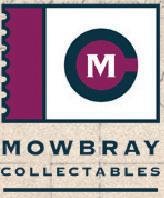
For the SW letter, the three markings that are seen as usual at the top of the cover were evidently applied to this cover in the same way. However, if the “PAID” cancel to the PP stamp on the SW cover was applied at the same time, it would have required a process quite different from all other examples. To apply “PAID” to the Millbury SW stamp as it is seen, the postmaster would have had to either (a) rotate the cover so the bottom of the stamp itself “squared up” with him and then carefully apply the “PAID” marking diagonally to the stamp (to place that word entirely onto the stamp) or, (b) with the cover in its typical position, rotate the “PAID” canceler in his hand and carefully cancel “PAID” completely, and diagonally, on the stamp. To have engaged in either process would have been unlike how any other Millbury cover was handled.
The contention here is that the best explanation for the SW cover is that the markings at the top of this cover (CDS, “PAID” and “5” rate marking) were applied with the usual process, but that the PP adhesive stamp affixed near the lower -left corner of the cover had been canceled before being placed onto the cover. In this schenario, the PP stamp on this cover had been carefully canceled with the “PAID” cancel entirely across the face of the stamp before it was affixed. That the stamp on the SW cover was indeed most likely precanceled is indicated by the fact that the word “PAID” on the stamp is struck completely on the face of the stamp, as one would expect a precancel to be struck, in contrast to every other use of the stamp with a “PAID” cancel. In those cases the word “PAID” was struck horizontally and, with studious precision, “PAID” appears partly on the stamp and partly on the face of the cover to which the stamp was affixed. When thus precanceled, the postmaster never had to engage in any machinations to produce the “PAID” cancel on the SW stamp; the stamp already was canceled “PAID” before it was affixed. This is the most logical explanation for what is observed.
Why was the PP stamp on the SW cover precanceled? Unlike virtually all other known adhesive postage stamps produced in the United States, the Millbury adhesive stamp was not made by printing from a plate that generated multiple stamps; it was made by (a) applying ink to a single-subject woodcut plate with the image of the stamp, (b) inking and stamping that single image onto a piece of paper with a hand press and then (c) cutting the single stamp in a square from the paper to make a single stamp.³ The creation of adhesive stamps by the postmaster of Millbury was, therefore, a laborious process. From the multiple letters shown in Figure 2 we have evidence that Sarah Waterman was a prodigious letter writer. It is suggested that to save time and effort, Henry Waterman supplied his wife with a number of Millbury PP stamps already stamped with “PAID” across the face, and she used them for whatever letters she subsequently wrote. When this was done, Henry Waterman did not have to take the time to make a separate adhesive stamp whenever his wife wrote a letter but, instead, he now received a cover already having a “PAID”-stamped adhesive on it, and simply had to apply the typical postmarks across the top of
296 www.collectorsclub.org September-October 2025
a cover/folded letter when his wife placed the letter into whatever receptacle Waterman used for outgoing mail. The foregoing explains why the SW letter Millbury stamp was very likely precanceled with ”PAID” before it was affixed to the cover.
Of potential interest here in regard to the postmaster Henry Waterman making PP stamps for his wife is the fact that the Millbury PP stamp affixed to the SW letter shown in Figure 1 is printed on the same paper as Sarah Waterman used for writing the letter shown in Figure 1. Thus, Postmaster Waterman used this same paper to make at least some of his PP stamps. The lettersheet paper and the PP stamp affixed to it are of exactly the same thickness (see footnote 5) and are also of the same color and composition. The fact that Henry Waterman used the same paper for the PP stamp as the Figure 1 letter was confirmed by A.J. Valente, a noted authority on stamp papers, after a detailed examination of this cover in 2011.4
For comparison purposes, two examples of covers where the stamp was canceled with the word “PAID” at the time the cover was mailed are shown in Figure 7. These examples show how the word “PAID” would be expected to be seen on the stamp (and also the cover) if the cancel were applied when the letter was mailed. The “PAID” cancel on the PP stamp on the SW cover is markedly different from these, and comparison of it to the covers shown in Figure 7 clearly illustrates the difference between covers postmarked at the time of mailing vs. processing of a cover that bears a previously precanceled postage stamp, as I’m proposing characterizes the SW cover.


Do we have any other evidence that the SW PP stamp was precanceled before being affixed to the cover? The answer is that the evidence is indirect, but “yes.” The SW Millbury adhesive postage stamp has a unique configuration of minor tears to its surface. The Millbury stamps were typically impressed upon thin blue paper, and therefore would seem to be susceptible to damage.5 But despite this, the Siegel archives of Millbury stamps, which documents all defects to every Millbury stamp and cover, indicates that only one other Millbury stamp has any tears to it.6 Perhaps the lack of tears occurred because almost all Millbury stamps were made by the postmaster and were immediately affixed to covers at the time the letter was mailed, so there was little opportunity for the postage stamp to be damaged. The Millbury adhesive that is torn is on a cover shown in Figure 3d. It can be noted that this cover has the most pronounced filing folds and surface dis-
www.collectorsclub.org September-October 2025
coloration of any Millbury cover, suggesting rough handing during its storage. It is speculated that this subsequent handling and filing of the cover may have produced the two significant tears to the left edge of the stamp. All other Millburys, including off cover stamps (except the SW cover), have no tears to the stamp. In comparison to these, the Millbury adhesive on the SW cover has a minor tear to the left edge of the stamp as well as a small tear at the upper-right edge of the stamp. It is unique in having small tears at both the left and right edge of the stamp. Why? My speculation is that this unique configuration of tears to the SW adhesive came about because, after being made by the postmaster with a number of other such stamps for his wife, the SW stamp spent some time in her possession, perhaps being handled “off cover” before it was affixed. I suggest that the thin, fragile bluish paper of the adhesive stamp experienced some minor tearing during this handling and storage before being affixed to the cover. This would account for the unique pattern of small tears at both the left and right edge of the SW Millbury PP stamp. If the stamp was not handled somewhat and stored prior to being affixed, how did these small tears to both sides of the stamp occur? It can be noted that the SW Millbury cover (Figure 1) has no filing folds or any indication of rough handling during storage after delivery to the recipient; the cover appears to have been well cared for after it was received. The unique pattern of small tears to both edges of the SW Millbury stamp is consistent with off-cover handling of the stamp before being affixed to the letter, thus providing additional evidence supporting the idea that the PP stamp on the cover shown in Figure 1 was a precanceled stamp made by the postmaster for use by his wife on letters that she would later write.
Finally, one notes the position of the stamp on the SW cover. The stamp is affixed near the lower-left corner of the cover, far from the top center where the majority of Millbury PP stamps were affixed, and assumed to be the location typically used by the postmaster. This, again, indicates the postmaster did not affix this particular stamp to the cover; rather, its position on the cover is consistent with the suggestion that it was his wife – writer of the letter – who put the stamp on this cover.
To summarize, this article has presented what I believe is compelling evidence that on the letter written by Sarah Waterman and mailed (postmarked) on March 6, 1846, the Milllbury PP stamp was precanceled, with “PAID” struck entirely across its face. Therefore it would be the first example of a precanceled stamp used in American postal history. I propose that, to accommodate his wife’s propensity for writing many letters, the postmaster of Millbury, Mass., provided her with a number of precanceled PP postage stamps to use on her letters, thereby saving him the time and effort needed to generate an adhesive stamp each time she wrote a letter. Because of the extreme rarity of Millbury PP stamps and covers, the conclusion presented here is unlikely to be confirmed by discovery of another example of such a Millbury precanceled stamp. However, the evidence would appear to strongly support that conclusion.
By way of concluding, it can be noted that there are, perhaps, other explanations for the unique “PAID” cancellation on the SW letter stamp. For example, it has been proposed to me that the postmaster may have made a number of his PP stamps and left them in a drawer or container for future use and that some other person – perhaps even his wife – was tending to the post office on the day or time this letter was mailed. That other person could have a stamped “PAID” on the stamp on the SW letter, and did so in a manner we clearly know is different from how the postmaster would have done it. (This would not, however, account for the three postmarks at the top of the SW cover being exactly as how the postmaster processed letters.) Nevertheless, one can suggest possibilities other than the stamp having been precanceled. I leave it to you to make up your own mind as to the most likely explanation. In my opinion, however, for reasons summarized in the previous paragraph, the data favor the stamp having been precanceled for Sarah L. Waterman by her husband the acting postmaster.
[Editor’s note: A detailed examination of the image would appear to reveal that both “PAID” markings on the Figure 1 cover were produced by the same device, but slightly different shades of ink could indicate they were applied at different times.]
Footnotes
1. Luff, J.N. The Postage Stamps of the United States, New York, Scott Stamp and Co., Ltd. 1902, pp. 27-28.
2. ibid., also Wall, Philip T. “The Millbury Postmaster Provisional Stamp,” The Chronicle, 1983, Vol. 35, No. 4, page 229 (fourth paragraph).
3. Wall, Philip T. “The Millbury Postmaster Provisional Stamp,” The Chronicle, 1983, Vol. 35, No. 4, page 229 (second paragraph).
4. A.J. Valente has authored the following books: Valente, A.J., Rag Paper Manufacture in the United States 1801-1900, Jefferson, N.C., McFarland and Company, Inc., 2016; and Valente, A.J., Paper History of Classical Stamps and Stationery, Claremont, N.H., Paper Antiquities, 2016.
5. The SW Millbury is on very thin paper, as mentioned in the text; it is, in fact, of exactly the same thickness and texture as the paper of the folded letter paper to which the stamp is affixed, the postmaster apparently having used this paper to make that stamp. Employing a Kafer thickness gauge, as well as a Mitutoyo thickness gauge, both of which are able to determine thickness of paper to a single micron, the author confirmed that the thickness of the paper for both the stamp and the paper of the letter sheet is 48 to 49 microns. To describe how thin this is compared to normal postage stamps, Carroll Chase in his book on the 3¢ 1851-57 issue, discussed the thickness of those postage stamps in detail (Chase, Carroll, The Three-Cent Stamp of the United States 1851-1857 Issue, Hammondsport, N.Y., J.O. Moore, Inc., 1929, pg. 145). He stated that the average thickness for imperforate stamps (1851-56) was 76 microns (Chase gave measurements in inches; those values translated here to microns), and for perforated stamps (1857-61), which were printed on slightly thinner paper, was 63 microns. The thinnest stamp Chase ever encountered on any 3¢ stamp was – this being a very rare event – 51 microns in thickness. For the 1861 issue, even the early thin-paper stamps rarely get thinner than 65 microns, with the stamps of the 1861 issue consistently being 70-90 microns in thickness (thickness paper measurements of more than 200 1861 issue 24¢ stamps made by author). Thus, the Millbury PP on bluish paper, if like the example in Figure 1, is on very thin paper.
6. All Millbury covers and stamps (5¢ Black on Bluish, Scott 7X1) are described at https://siegelauctions.com/resources/census/us/scott/7X1. A detailed description, including condition and any defects, is given for each cover and Millbury PP off-cover stamp.
300 www.collectorsclub.org September-October 2025
We invite you to discover these once-in-a-lifetime collections!
November 2025: Canada Part I
Canada Pence, Cents & Large Queens
Spring 2026: Newfoundland Part I
Newfoundland Pence to Airmails
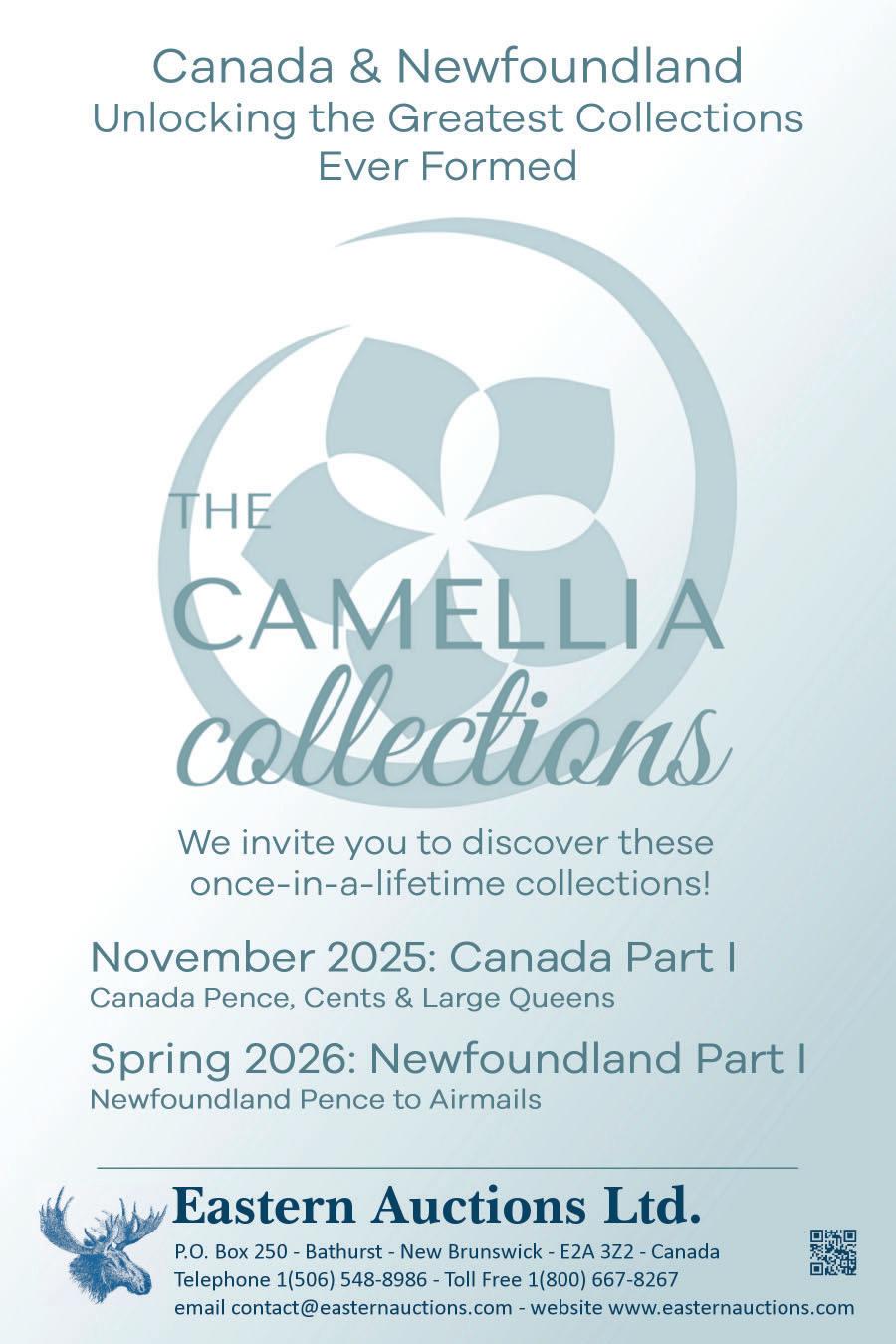
emai l contact@easternauction s.com - website www.easternauctions.com
Introduction
A.J. Valente
While it is true there have been a number of detailed works on the subject, there remain major disagreements on the part of experts and specialists as to ultimately how the grilled issues were produced. Initially, as documentation was sparse, theories abounded. More recently the Travis Papers and, presently, the Brazer Archives have come to light. These documents greatly aided philatelic researchers and brought the hobby closer to the ultimate answer.
Firstly, it is important to understand there are two categories of stamps. The fi rst are essays, those produced by the design bureau. Essays are carefully engraved and produced in limited numbers for the purpose of evaluation and approval by the principals involved. Personnel who produce essays are artists, designers, machinists and printers. The bureau advances the process as far as creating plates, selecting inks, paper and so on. The second case relates to the mass production of stamps at the printer. Each printer uses its own ink and paper, which is geared to an overall cost savings. Thus, in their separate roles, the design bureau and stamp printers work hand-in-hand to produce the fi nal product.
In examining prior written works on the subject of grilling, the general approach of philatelic research has been to reverse-engineer various essays to arrive at the method of factory production. This seems a logical path for exploration and does produce some valid theories. Thus theorists, some of whom are quite prominent in the hobby, focused intently on the crafting and creation of essays. Although essays validate the printed design, grilling is more a matter of processing paper. The printer needed to produce some 10 million stamps a month. So, how could that be accomplished? This is the thesis of the present article.
By 1853, manufacturing stationers had adapted embossing by means of stamping, such as the case of the Nesbitt envelopes. However, there was another related process known as “debossing.” In debossing the impression is produced in intaglio, that is, the reverse of embossing (Figure 1). Charles Steel, the superintendent of the National Bank Note Co., had in his Postage Stamp patent (No. 70-147 of Oct. 22, 1867) proposed, “I press the sheet between embossed plates or pass it through between embossing rollers ... “¹ Debossing and embossing are technical terms often used interchangeably (Figure 2). Steel's original intent had been embossing, but gradually his work migrated into debossing. In debossing, the paper
302 www.collectorsclub.org September-October 2025
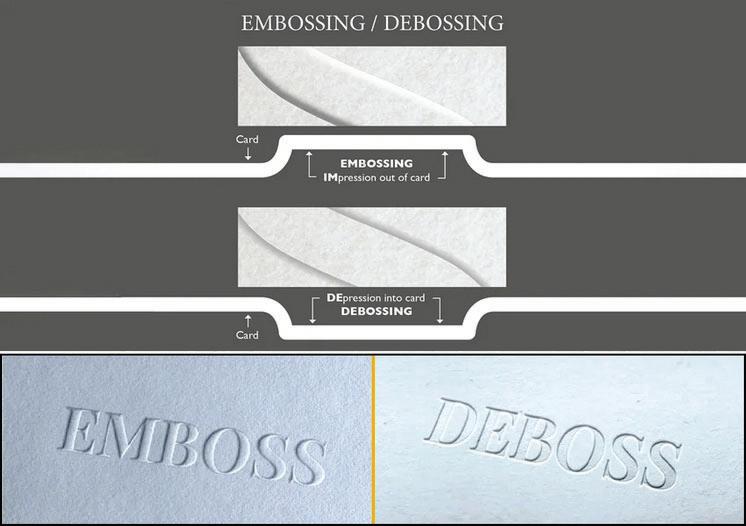
Figure 1. Illustrative of the embossing/debossing processes: Embossing is done by a plate possessing surface ornamentation (die) that when pressed into paper produces a raised impression. Debossing is done by roller containing an inverted pattern that under sufficient pressure produces a hollowed out image in the paper.

Figure 2. Embossing and debossing are terms often used interchangeably. Here the caption reads embossing, even though a debossing roller containing an inverted pattern of artwork is doing the work.
104, Number 5 Collectors Club Philatelist is forced into the hollows of the pattern.² The advantage of debossing is that it doesn’t interfere with the other side of the paper it's acting upon, namely the face of the stamp(s). A clean grill penetrating the paper from the reverse with minimum affect on the printed image became the effect Mr. Steel was aiming for.
Discussions between United States Post Office Department officials, the National Bank Note Co. (NBNC) and various independent entrepreneurs regarding efforts to defeat the chemical washing of postmarks began shortly after the end of the Civil War. Certain proprietary methods were gaining interest, so Charles Steel submitted his own idea to the patent office in 1867 writing, “... my method consists of embossing or partially breaking the paper, so as to open the texture of the paper along certain lines, without removing any part thereof. This causes the stamp ... to stick better and allows the oil of the cancellation-ink ... to strike in very deeply.”¹ In other words, breaking up the fibers of the paper allowed canceling ink to more easily penetrate the paper to discourage removal of cancels. Accompanying the application were experimental grills made by stamping with a small metal die and cast.¹
In his patent, Mr. Steel had been careful not to give away too much of the technical details of the production process, writing “I do not deem it necessary to describe the devices for embossing ... “ And, indeed, while his patent had long been available to philatelic researchers, the actual methods used in producing the stamps remain a mystery to most.
Third Assistant Postmaster General A.N. Zevely wrote Charles Steel a letter dated Oct. 23, 1867, saying in part, the postmaster general was sufficiently impressed and gave the go-ahead to proceed.³ In Postmaster General Randall’s former position as governor of Wisconsin, he had rooted out corruption associated with the distribution of federal railroad land grants. Now, amplifying the fears of the embattled Johnson Administration, Randall authorized the embossing of postage stamps as a measure against fraud.³
Going from a simple die-cast impression to large-scale production of stamps was a big step. What Charles Steel refers to in his patent regarding the use of a grill roller makes the best sense.1 A debossing roller with a smooth surface, when paired with a blank roller in a calender machine, can be run at high speeds. NBNC took the lead in developing the roller. The process began with fabricating a steel plate on a geometric lathe, then a roller made of brass would be pressed into the plate. The initial essay would be signed off by the lathe operator, Alex Duke.⁴ This design, called the “A” grill, covered the entire roller with pyramidal grills. The debossing roller was then taken from the design bureau at 1 Wall St. in New York City to the printer at the corner of Pine and Nassau St. Here the grill roller was installed, along with a plain roller, into a calender machine (Figure 3). In these early production trials the debossing roller was affixed in the top position. Thus, as the sheets were fed face-up into the machine the debossing created designs on the face of the sheet with the pyramids “points up.”
The initial trial proved less than a success, as the grilling weakened the paper to the extent that the stamps fell apart at the perforations. For this reason, the grill work would be trimmed back into rectangular sections so the debossing
304 www.collectorsclub.org September-October 2025
just fell on the center of the design, avoiding the gutter regions.⁵ Apparently, the initial plate had been reused by burnishing the design into these rectangular sections now called a “B” grill.⁶ The burnishing was not entirely successful as some ghost of the grill work could be seen in the plate and on the new roller. This we know because a few stamps made from the B roller exhibit left-over impressions of the burnished areas.
Now it became necessary to create a brand-new plate and roller. This grill, called a “C” grill, possessed the same pyramidal shapes as before and, again, were organized in rectangular patterns. Now the objective became getting the calender up to speed to match the pace of production. About four to eight sheets per minute would be the goal. This latest production trial would be limited to the 3¢ stamp only. Apparently, the early pyramids with their tiny pointed tips tended to cause the paper to stick to the debossing roller momentarily before releasing. This delay had been just enough to prevent the calender from operating at higher speeds. So, most probably for this reason, it is believed the C roller was abandoned.
Information regarding roller construction from a plate is fairly confirmed by a letter of the president of NBNC, Mr. Fitch Shepard, who wrote about the costs involved, saying, “... We are largely damaged by making special plates, adjusting our machinery, &c.”⁷ It is believed the process involved affixing the “special plate” to a table, where a roller made of brass was carefully aligned and “run-in” under great pressure. The plate also served as a template to create a roller with exacting patterns. Note, the president only complains about the steel plates, not the brass roller, the latter having higher intrinsic value in recycling.
All Collectors Club presentations are currently held online, via ZOOM, beginning at 5:30 p.m. (Eastern). Although there is no cost, pre-registration is necessary.


Charles Steel said very little, and only one letter by him is known from the development period. Getting back to his patent, Steel proposed: “My improved stamp be more cheaply produced than any stamps adapted to effect this purpose ...“1 Feeding sheets into the calender was more or less a continuous process. Two workers were employed, although some machines could be operated by a single person (Figure 3). The machine needed to run rather swiftly to keep up with the pace of production, which was about 50,000 sheets a month (or 100,000 panes equaling 10 million stamps). Calendering was something of an art, as a great deal depended on the experience of the operator. The machine did require periodic tuning, as the cylinders tended to separate over time (note Figure 3 control wheels “a.”). For this reason, many grills tend to be faint or less than perfectly formed.

The basic sheet calender possesses two rollers, one of metal (brass, iron or copper-clad wood) and a second of similar material.⁸ The grill roller consisted of a rectangular patterns containing rows of inverse pyramids. Sheets fed into the calender came under pressure, forcing the paper into the pyramidal voids resulting in a grill pattern. A certain moisture content is also needed to give the paper the necessary pliability (Figure 4).

4: A “D” grill on cover. The stamp was debossed from the rear, but note the prominent pattern on the front. This happens when the paper has high moisture content and more freely flows into the grill recesses. A paper with more modest moisture content will tend to show the grilling less prominently on the printed side.
Con fi rmation of the calendering process comes by way of an 1873 le tt er accompanying NBNC’s bid for an upcoming stamp contract. The contract required embossing and, in an e ff ort to devolve that requirement, National’s president, Mr. Shepard, a tt ached a le tt er penned by a well-known paper mill owner who provided expert opinion on the calendering process. The le tt er by Mr. William Whiting of Holyoke, Mass., reads, in part (underscoring mine):
"... the Steel Patent by which the fi ber on which the postage stamps are to be presented, is, to a certain extent, crushed ...
“You have styled your stamps as ‘embossed’ and this is reasonably correct, but I used the word ‘crushed’ in reference to the fiber as this expressed the most important part of the result produced."10
Mr. Whiting's le tt er is something of a smoking gun, as it points out that calendering smooths the surface of the paper by crushing it between rollers. In one of his memos of mid-December 1867, Mr. Zevely inadvertently addressed that same subject writing that, “The appearance of the three cents and two cents stamps seem dull and lifeless compared with the original specimens ...” ⁵ And this is true! He was talking about a comparison with the normally raised impressions of the 1861 issue produced by intaglio printing. Running one's nail across a stamp of 1861 one can feel the ridges of the engraved printing. Doing the same with an grilled variety of 1868 fi nds the surface rather fl at and featureless – the result of being crushed smooth by calendering. It should also be noted that most production stamps take about four to six weeks to reach distribution. Thus, Mr. Zevely was likely describing either the “D” or “Z” grill varieties that appeared in post o ffi ces around late January and early February of 1868.
The prominence of embossing over the face of the stamps also drew some unwanted attention from Mr. Zevely, who wrote, on Dec. 31, 1867, “Let me ask you to make careful experiments, and send me sheets (sic) prepared as follows. viz. embossed effectually immediately after being printed; then calendered(sic) or pressed so as to conceal the embossing and finally gummed.”⁹ Zevely evidently had little knowledge of the calender, not knowing how it was being used, and probably only hearing Mr. Steel mentioning it. Steel had already began debossing the stamps from the reverse (D and Z grills), but paper with high moisture content will show the grilling rather prominently on the face.
Another problem previously mentioned here was the paper sticking in the points of the pyramids and not releasing as quickly as desired, thus slowing the calender down. The design bureau took up the problem and returned with an improved pyramidal design. The D and Z rollers now possessed pyramids designed with ridges at their peak instead of simply coming to a point. The lathe was apparently reprogrammed to produce this so-called “roof top” design.4 Interestingly, the D grill had ridges running parallel to the direction of motion (vertically), while the Z grill had the ridges running horizontally. So, two different rollers were tried by the printer in a kind of competition. The idea was that by squaring off the tips of the pyramids the paper would release more quickly and allow the speed of the calender to be increased. After trying both rollers, the the D roller was apparently better and, for that reason, the Z roller was shortly abandoned.
308 www.collectorsclub.org September-October 2025
To avoid unduly affecting the face of the stamps, as Mr. Zevely had requested, the D and Z rollers were installed in the bottom position of the calender. Sheets were fed in face-up, as before, only now debossing the back of the sheet causing the grills to now appear “points-down.” It’s also important to note that, by February 1868, most grilled stamps distributed to the public consisted of the “E” grill that was noticeably smaller, measuring just 11 by 13mm. The smaller grill might be seen as more difficult to effect centering over the stamps, but evidently the smaller rectangle allowed the machine to run even faster. For this reason, when grilling continued on the 1870 issue, the size of the rectangle became smaller in size than on the 1868 issue (Figure 5).
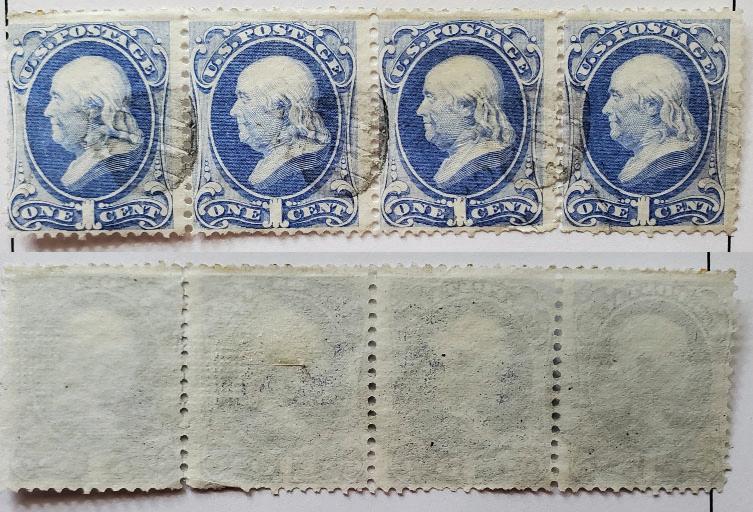
The roller-plate theory proposed by Stephenson in his 1914 article is defunct. To arrive at “points-up” and “points-down” condition, Stephenson had the face of the stamps “debossed” by the fi rst grill rollers. Then, later, his rollers “embossed” the face of the stamps, due to the need for the sheet to be processed face-up on the table. Clearly, most impressions appear stronger on the reverse than on the face, meaning they were all debossed from the back. Finally, the roller and plate process introduced by Mr. Stephenson and illustrated by Lester Brookman in his book (Figure 6) could never work for Mr. Steel in the factory. Steel himself said the stamps would be passed between embossing rollers – plural. As reported by the Stamp Agent, the factory printed 50-75,000 sheets per month. One might be able to spin Mr. Brookman’s roller over the plate a bit faster, but the equipment still had to be stopped between replacing sheets. Here one gets perhaps one to two sheets a minute, nothing close to production requirements.

Endnotes
1. Charles Steel Postage Stamp patent No. 70-147, Oct. 22, 1867.
2 Jan Hofmeyr, Understanding the Grill Stamps of the United States, Jan Hofmeyr, Victoria, BC, Canada, Version 2, 87-88 and Figure 48.
3. Alexander Zevely, letter to Charles Steel, Brazer Archive, Oct. 8, 1867.
4. Understanding, ibid, 91 and Figure 62.
5. Alexander Zevely, letter to Fitch Shepard, Traver’s Papers, Dec. 16, 1867.
6. Lester Brookman, The 19th Century Postage Stamps of the United States, Volume 1, H.L. Lindquist, New York, N.Y., 1947, page 280.
7. Fitch Shepard, letter to Alexander Zevely, Brazer Archive, Dec. 9, 1867.
8. A.J. Valente, Rag Paper Manufacturing in the U.S., 1801-1900, McFarland & Co, 2010, pp. 22-24.
9. Alexander Zevely, letter to Albon Man, Brazer Archive, Dec. 31, 1867.
10. William Whiting letter, Traver’s Papers, Jan. 10, 1873.
310 www.collectorsclub.org September-October 2025








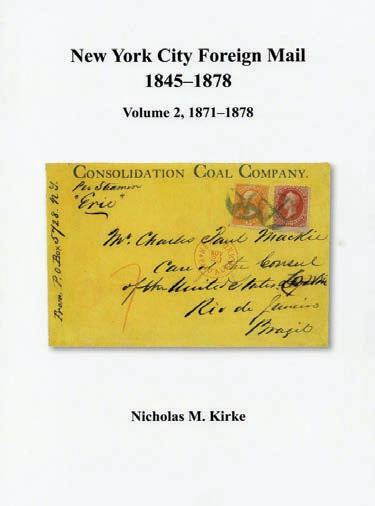

















Preparing for the Great War: West Point Cadet Henry Henley Chapman, Class of 1917; Correspondence Home, by Richard G. Lomax, 8½ by 11½ inches, softbound, 86 pages plus cover, Military Postal History Society, Monograph No. 3, 2025, ISBN 979-82845-5117-2, $13.95 plus shipping from Amazon.com.
This monograph, part of an ongoing series published by the Military Postal History Society depicts West Point United States Military Academy as it prepared for the Great War (World War I), as seen through the eyes of one student, Cadet Henry Henley Chapman. Chapman was a West Point graduate, class of 1917, who went on to a leadership position in the Great War in France.
Although it may sound trite to refer to a monograph as a “slice of life,” it does just that, utilizing philatelic, photographic and historical documentation to trace Chapman’s life, chronologically, as he progressed through West Point and on through his entry into the war.
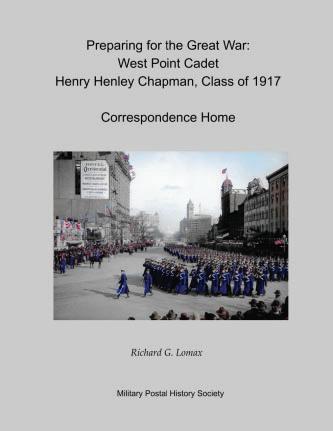
The first chapter, however, traces Chapman’s ancestral background, which is rich in military heritage, beginning with his great-great grandfather, Lt. Henry Henley Chapman (1764-1821), who served under George Washington during the American Revolution. Other relatives served as veterans of the Mexican, Indian and Civil wars, as well as the Cuban and Philippine wars and the Spanish-American War.
The second chapter is titled “The Early Years,” which follows Chapman’s life up to his entrance to West Point. He was born Aug. 8, 1894, in Assiniboine, Mont.
As this monograph relies heavily upon correspondence, it’s interesting to not he wrote his earliest-known letter to his mother Oct. 2, 1912, shortly after his arrival at Schadman Columbian Preparatory School, which served as a feeder school for the Army and Naval Academies. Chapman, at age 18, was surprised to find that he already knew a number of the boys – some of these young men he also would encounter at West Point.
One odd, somewhat random passage in theis letter notes: “Mr. Schadman does not believe in dolls so we can’t have anything to do with them. We are colled women haters. Ain’t that terrible.”
The chapter ends with Henry’s admittance to West Point June 15, 1913, as part of the Class of 1917.
The next four chapters follow Chapman’s journey through the Plebe, Yearling Cow and Firstie years, culminating with his graduation from West Point – again, reinforced through correspondence, photographs and other historical documents that bring a flavor of the time.
Chapter 7 covers his training, where he was commissioned as a 2nd lieutenant with the 20th Infantry (his father and grandfather also served in the 20th). By Aug. 5, 1917, he had progressed as a first lieutenant and then to captain, where he was first assigned to Fort Douglas, Utah.
Chapter 8 covers his brief time serving in World War I. He left New Jersey May 10, 1918, aboard the Dante Alegheiri for France, beginning his service there on May 23.
Ultimately, Capt. Chapman gave his life for his country on Sept. 29, 1918, at the age of 24, leading his troops over the top in the first wave of the Battle of Bellicourt. He was killed instantly by a rifle ball to the chest. A final chapter (9) gives a chronological review of personal aspects of Chapman’s brief life.
Anytime one utilizes a single source of correspondence to capture a snapshot of history, one risks either trivializing or mummifying the subsequent prose. Through the generous use of other documents, photographs and sources of information, I believe Lomax avoids this pitfall.
—
Wayne Youngblood

When philatelists from Germany and abroad gather in the auction hall of Heinrich Köhler in Wiesbaden on Nov. 13 for two days, there will be only one thing on their minds: philatelic literature! The International Association of Philatelic Journalists (AIJP), the world association of philatelic authors and journalists, has succeeded in bringing together 20 speakers from Europe with topics that reflect the fascination, magic and significance of philatelic literature.


13 to 14 November 2025
Sale of The 'PARIS' Library of Philate lic Lite r a ture
15 to 16 November 2025
England is represented by seven speakers, including David Beech (Member of the Order of the British Empire, Fellow of the Royal Philatelic Society of London, MBE FRPSL), former curator of the philatelic department at the British Library, and Brian Birch (FRPSL), arguably the world’s leading bibliographer of philately. Germany’s representatives will provide overviews of philatelic antiquarian bookshops worldwide (Björn Rosenau) and aspects of the preservation and conservation of philatelic literature that are important for everyone (Dr. Andreas Hahn, curator of the philatelic archive of the Museum Foundation for Post and Telecommunications in Bonn). Last but not least, the philatelic libraries from Germany (Frankfurt, Hamburg, Wuppertal) and England (RPSL) will introduce themselves.
Italy will be represented by two speakers: Dr Giancarlo Morolli (Royal Distinguished Philatelist, FRPSL) will talk about new Federation of European Philatelic Associations (FEPA) regulations for literature exhibitions, and Dr. Claudio Manzati will discuss the perhaps crazy idea of establishing a new premium product on postal history (“Posthorn”) in these times. This fits in well with Douglas Muir (RDP FRPSL), former head of the British Postal Museum and a well-known author, who will present the Stuart Russiter Trust from Great Britain, which is particularly committed to promoting postal history. And not just British postal history!
Switzerland is represented by Heinz Glättli (FRPSL), who has interesting facts to share about earlier literary “name sales,” and by International Federation of Stamp Dealers Associations (IFSDA) President Hans Schwarz, who will describe the beginnings and development of philatelic literature in Switzerland.
Two representatives of the Zurich auction house Corinphila are also sure to shine: Karl Louis (FRPSL) on the subject of research in philately, and Jonas Hällström (RDP FRPSL), who will introduce participants to valuable monographs from the Royal Philatelic Society London and those awarded the Crawford Medal. Other speakers, such as Chris King (RDP Hon FRPSL), James Podger (FRPSL), John W. Jackson (FRPSL) and Vincent Schouberechts (FRPSL), will be presenting their topics in the event program, which can be downloaded from the Heinrich Köhler auction house website (https:// hk-files.s3.eu-central-1.amazonaws. com/PDFs/Brochure_Literature-Summit_PARIS-Library_195-270.pdf).

On the afternoon of Nov. 14, a onehour AIJP congress will take place to conclude the event. This time, it will be something very special, because – after 20 years – Wolfgang Maassen, president of the association, will be passing on the baton. Three new candidates (Ari Muhonen from Finland, Paul Wijnants from Belgium and Abhishek Bhuwalka from India) are running for election to the post, while Hans Schwarz from Switzerland, the long-standing treasurer, and Rainer von Scharpen from Germany, the equally long-standing secretary general, are both running for another term of office.

One speaker deserves special mention: Tomas Bjäringer from Sweden, who will present the unusual topic of “The 25 most expensive philatelic books in the world.”
In 1879, the Royal Philatelic Society London published its first book: the Catalogue of Postage Stamps, Stamped Envelopes and Postcards. Today, only a handful of these books are still known to exist, and certainly none in such excellent condition.
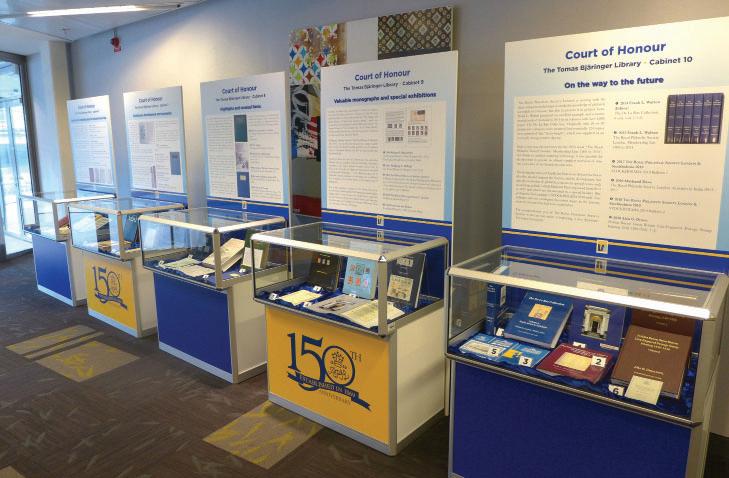
He knows what he is talking about, as Bjäringer has been collecting philatelic literature for many decades with a keen eye for quality, preservation and rare variants (such as dedications, signatures, small and special editions and the like). Anyone who visited the auction room at Heinrich Köhler in September 2024 or March 2025 will have noticed the floor-to-ceiling, artistically crafted bookshelves filled with approximately 2,500 monographs. This was part of Bjäringer’s unique library, which will be auctioned in Wiesbaden on Nov. 15, following the conference. Of course, the 25 “world rarities” of philatelic literature are included, but also countless standard works and small brochures that are only inconspicuous at first glance and are rarely available. Other large collections (especially magazines, exhibition and auction catalogs from the last 100 to 150 years) were stored in other premises until a few months ago and have only recently been cataloged.
A fi rst overview of this magni fi cent private library was published in December 2024 under the title “The ‘PARIS’ Library of Philatelic Literature.” Paris, because its owner lived in that city for many years.

The Bäringer Library contains numerous early catalogues from various countries dating back to 1862, most of which are stored in special boxes for protection. The library will be sold Nov. 15.
The auction catalog is online; 3,000 copies were printed and sent out to interested parties at the end of August. Those interested in literature can request this unusual 312-page(!) catalog from the Wiesbaden auction house or download or view it on the website www.heinrich-koehler.de The same applies to the conference program, which lists all topics and speakers on eight pages, as well as planned evening events and everything you need to know about travel, hotels, parking and more. The conference language is English, but translation assistance will be provided if required.
Contact: Dr. Daniela Weinstock, Auktionshaus Heinrich Köhler, Hasengartenstr. 25, 65189 Wiesbaden, Germany.
email: info@heinrich-koehler.de
Website: www.heinrich-koehler.de

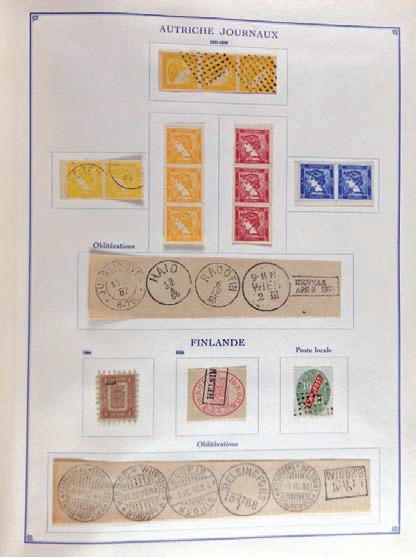
A unique example of the 1928 Fournier facsimile album. This album is numbered and contains a handwritten dedication from the president of the Union Philatélique de Geneve, E. Friederich, who later became Swiss president of the FIP, to Fernand Serrane, a well-known Belgian philatelist and author.


Bolaffi S.p.A. Announces the Death of its Honorary President, Alberto Bolaffi
It is with deep sadness that Bolaffi company announces that its Honorary President, Italian Cavaliere del Lavoro (Order of Merit for Labor), Alberto Bolaffi passed away on July 16, at the age of 89. As the third generation at the helm of the family business, he led the company from the early 1960s until 2013.
Alberto Bolaffi played a key role in the growth and success of Bolaffi S.p.A., honoring the tradition started by his grandfather in 1890 and giving a significant boost to the philatelic trade both nationally and internationally.
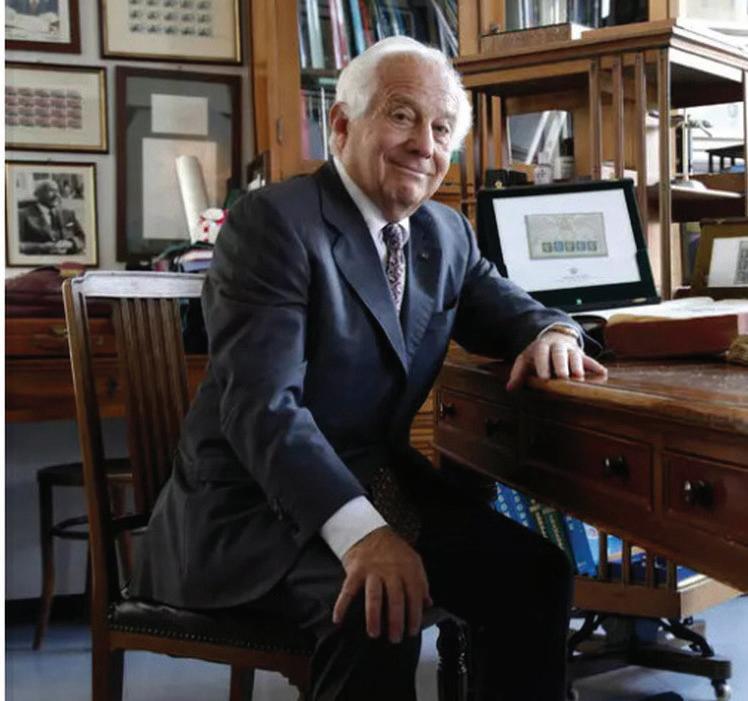

In 1992, he signed the Roll of Distinguished Philatelists (RDP). Alberto Bolaffi was one of only two non-British honorary members of the Royal Philatelic Society London (RPSL), holding the title since 1994. In 1997, he was awarded the Tilleard Medal by the Royal Philatelic Society London for his exhibit, The Story of the Risorgimento Italiano, through its stamps. In 2016, he was awarded the Hunziker Medal by the Association Internationale des Experts Philatéliques (AIEP) of which he has been a member since 1983.
In 1991, Boloffi was honored on a stamp from Italy, Scott 1857, which was released for that year’s Stamp Day. His grandfather, Giulio, was also depicted.
Boloffi has been a member of the Club de Monte-Carlo since its founding in 1998. He was “associé étranger” of the Académie de Philatélie and a member of the Académie Européenne de Philatélie (AEP). He is survived by his two sons, Giulio Filippo and Nicola, and two beloved grandchildren, Alberto Leone and Tancredi.
— Primary source for obituary: https://fepanews.com/alberto-bolaffi-1936-2025/
Membership Update: June 14 through Aug. 10, 2025
Approved by the Board of Governors:
July 1, 2025
Non-Resident:
Klimley, Ronald J. Tampa, Fla. Pistell, Lawrence Bath Maine
July 29, 2025
Non-Resident:
Urushima, Andrew K Burlingame, Calif.
We have been recently notified of the following deaths: Bolaffi, Alberto; long standing professional and father of Member Giulio Filippo Bolaffi Boyd, Robert; long standing Member
If you would like to update your contact information, please contact our Executive Secretary Andrea Matura at: info@collectorsclub.org
We appreciate the continuing outreach efforts in collaboration with the Philatelic Foundation and major auction houses in membership recruitment. Upcoming meetings at the Club continue throughout the year. Our ongoing 2025 remote “Zoom” and combined “Zoom + Live” meeting series is in progress.
We eagerly anticipate our annual Single Frame Competition coming Nov. 5, and ongoing events at the Clubhouse throughout the 2025-2026 season! Please check the full schedule that appears on page 260.
Plan on attending the annual Nojex World Series of Philately-level stamp show this Sept. 26-28 in Hasbrouck Heights, N.J., See you there!
Respectfully submitted, Mark E.
Banchik, Membership Chair
Page
Advertiser
Page
Inside Fr. Cvr. Stanley Gibbons
311 Collectors Club
268-269 Corinphila Auctions Ltd.
301 Eastern Auctions
277 David Feldman
Advertiser
272-273 Heinrich Köhler
320 Minuteman Press
295 Mowbray Collectables
Inside Back Cvr. Schuyler Rumsey
Back Cover Robert A. Seigel
Those who advertise in the Collectors Club Philatelist are supporting both our organization and the hobby in general.
If you purchase stamps or covers from these fine companies, please let them know you saw their ad in the CCP.
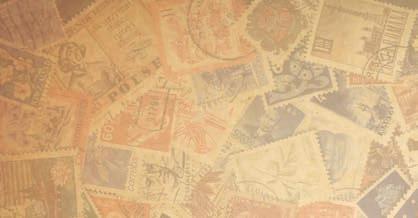


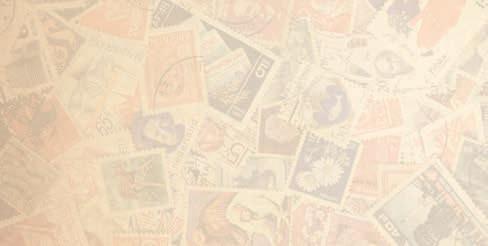





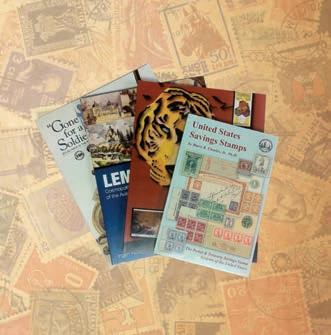

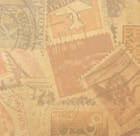


Consign now to this important event to be held at the Boston Convention and Exhibition Center (May 23-30, 2026)


Knowledge. Experience. Integrity. Things that cannot be bought, bartered or sold. Yet they’re responsible for realizing the highest prices for your stamps. At Rumsey Auctions, we’ve built our reputation on these qualities as much as on the impressive financial results we achieve for our clients. Please call or email us and let us show you how much we can do for you.
415 781 5127srumsey@rumseyauctions.com visit us at rumseyauctions.com When
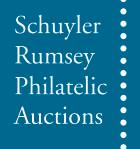

By order of the trustee, Siegel International will offer additional items from The Magnolia Collection of India Stamps and Postal History on September 30, 2025.




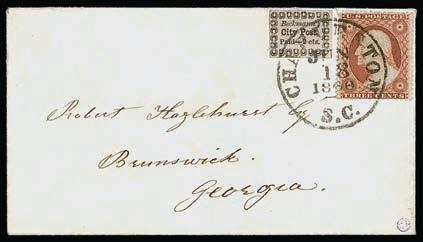
The centenarian philatelist’s collection of Carriers, Local Posts and Independent Mails stamps and covers will be offered in October 2025. It features the unique Beckman’s stamp on cover. a ,(,,,:..,,n,4-u/7'~cfoc- ~"'°CL..),

